Multi-Phase Dolomitization in the Jurassic Paleo-Oil Reservoir Zone, Qiangtang Basin (SW China): Implications for Reservoir Development
Abstract
:1. Introduction
2. Geological Background
3. Samples and Methods
3.1. Samples
3.2. Methods
3.2.1. Classification Schemes
3.2.2. Petrography and Microfacies Analysis
3.2.3. C-O Isotopes
3.2.4. Trace Elements and Rare Earth Elements
4. Results
4.1. Outcrop Description
4.2. Dolomite Texture
4.2.1. Replacive Dolomites
4.2.2. Dolomitic Cement
4.2.3. Ghost Structures
4.3. Microfacies Analysis
- MF1
- Homogeneous Mudstone
- MF2
- Peloidal Packstone
- MF3
- Ooidal Grainstone
- MF4
- Well-Sorted Bioclastic/Intraclastic Rudstone
- MF5
- Poorly Sorted Bioclastic and Intraclastic Rudstone (without Mud) to Grainstone
- MF6
- Poorly Sorted Bioclastic and Intraclastic Rudstone (with Mud) to Packstone
- MF7
- Bioclastic Floatstone to Rudstone with Better Preserved Fossils
- MF8
- Subrounded Rudstone
- MF9
- Microbial Bindstone
- MF10
- Stromatolite
4.4. Geochemical Evidence
4.4.1. Stable Carbon and Oxygen Isotopes
4.4.2. Trace Elements and Rare Earth Elements (REEs+Y)
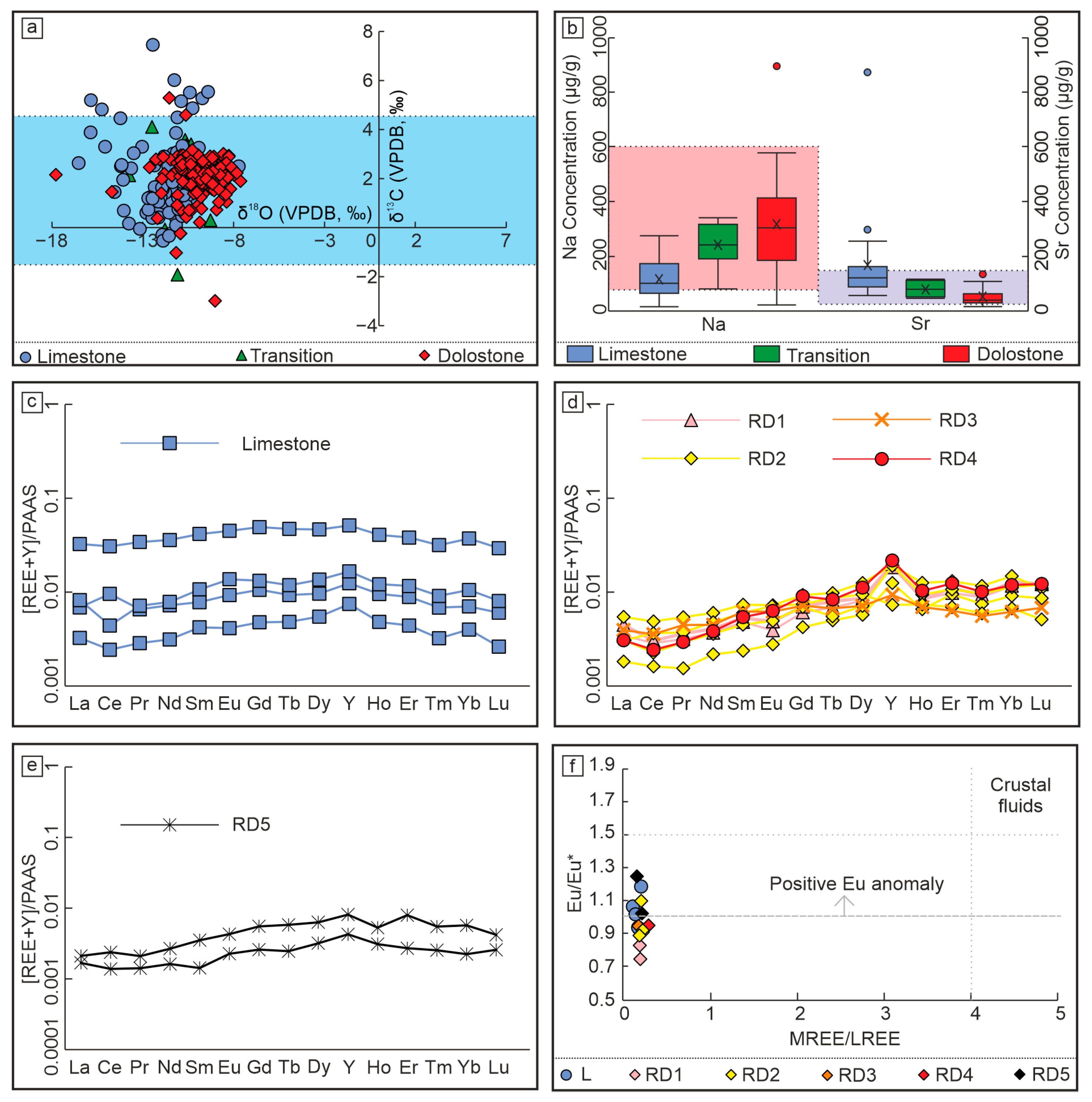
5. Discussion
5.1. Depositional Environment
5.2. Reconsideration of the Strata Age
5.3. Timing of Dolomitization
5.4. Dolomitization Processes and Hypothesis
5.4.1. Near-Normal Seawater Dolomitization
5.4.2. Saddle Dolomite in Limestones
- (1)
- Saddle dolomites are directly formed in a subsequent diagenetic stage (after lithification) during deeper burial conditions. This, however, is probably not the case because the majority of the saddle dolomites are not associated with veins, but rather occur preferentially in empty space (Figure 7 and Figure 8). Furthermore, it might also be difficult for saddle dolomite to replace calcite cement (Figure 8a,b). It has been documented that in instances when saddle dolomite grows together with calcite cement, they exhibit competitive growth [118].
- (2)
- Non-saddle dolomites formed in the pore space during lithification, and in a later diagenetic stage (after lithification), they recrystallize into saddle dolomites. It is difficult to prove this hypothesis, given the limited evidence available. One observation might support this hypothesis. If saddle dolomite crystals present only straight outlines, it might suggest a transformed “normal” dolomite crystal into a saddle dolomite. This, however, was not convincingly documented in the investigated samples.
- (3)
- Saddle dolomites are formed early, either through the recrystallization of former “normal” dolomites or through direct precipitation, after an initial lithification (at least after partial lithification) and the subsequent dissolution of aragonite, but before calcite precipitation in the moldic pores or in the remaining interparticle pore space (Figure 17). Some saddle dolomites, which are surrounded by calcite cement, exhibit curved outlines (Figure 7c–f). This phenomenon indicates that these saddle dolomites were already “saddle” before the calcite precipitation in the moldic pore and the remaining interparticle pores. Saddle dolomite within interparticle pores was also observed by Martín-Martín et al. [121]. It is unlikely that the temperature required for saddle dolomite formation can be provided by the burial depth, where early lithification occurs. However, hydrothermal dolomitization might occur even in near-surface to shallow burial depths (syn. to early post-deposition [122], <100 m [123]), and it can even breach the sea-floor [124]. This potential scenario appears to be more plausible.
5.4.3. Hydrothermal Dolomitization and Recrystallization
5.4.4. Paragenetic Sequence
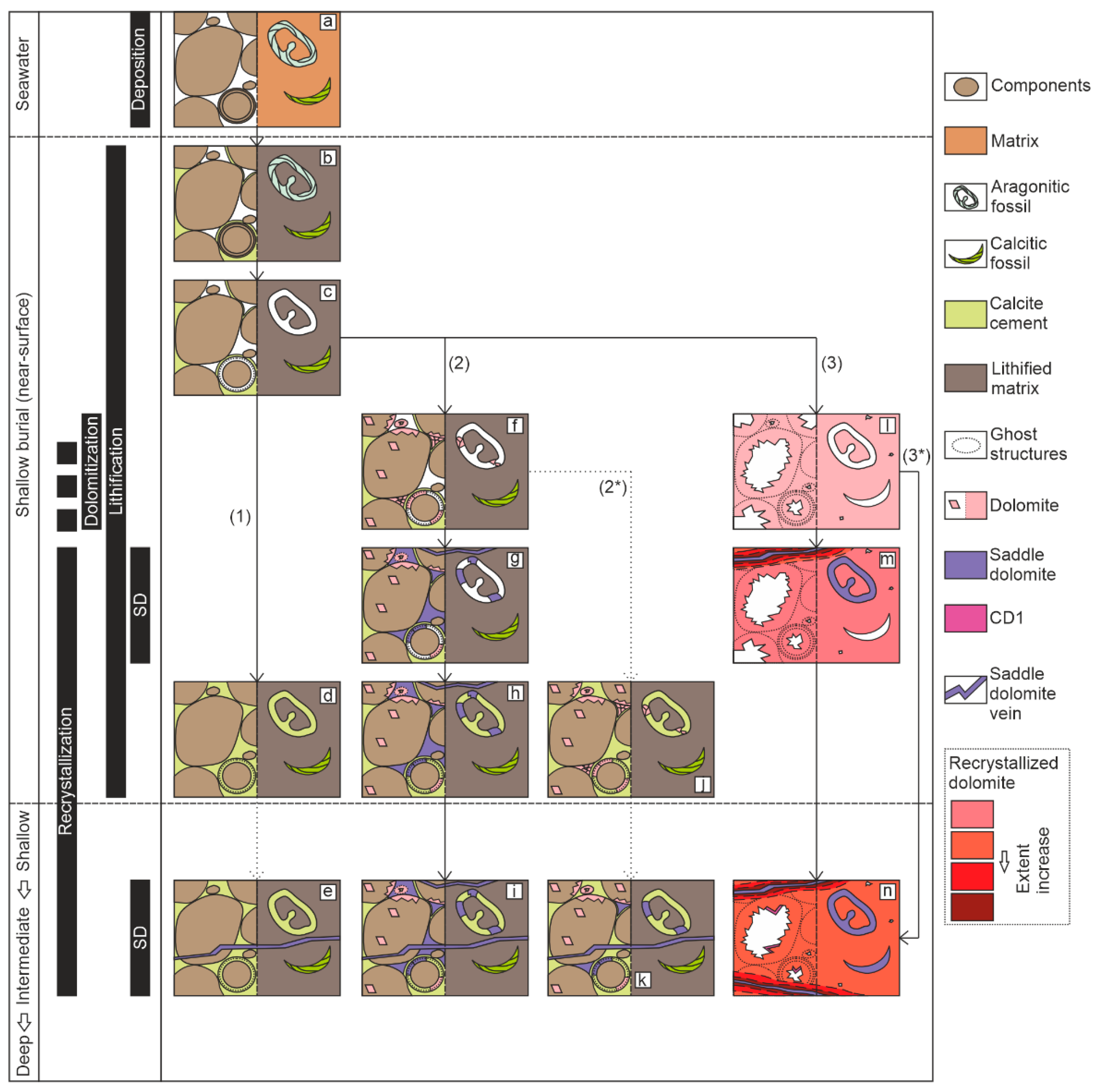
5.4.5. Dolomitization Hypothesis
5.5. Implication for Dolostone Reservoirs Exploration
6. Conclusions
Author Contributions
Funding
Data Availability Statement
Acknowledgments
Conflicts of Interest
References
- Given, R.K.; Wilkinson, B.H. Dolomite abundance and stratigraphic age: Constraints on rates and mechanisms of Phanerozoic dolostone formation. J. Sediment. Petrol. 1987, 57, 1068–1078. [Google Scholar] [CrossRef]
- Kolchugin, A.; Immenhauser, A.; Morozov, V.; Walter, B.; Eskin, A.; Korolev, E.; Neuser, R. A comparative study of two Mississippian dolostone reservoirs in the Volga-Ural Basin, Russia. J. Asian Earth Sci. 2020, 199, 104465. [Google Scholar] [CrossRef]
- Shen, A.; Hu, A.; Pan, L.; She, M. Origin and distribution of grain dolostone reservoirs in the Cambrian Longwangmiao Formation, Sichuan Basin, China. Acta Geol. Sin.-Engl. Ed. 2017, 91, 204–218. [Google Scholar] [CrossRef]
- Swart, P.K.; Cantrell, D.L.; Westphal, H.; Handford, C.R.; Kendall, C.G. Origin of dolomite in the Arab-D Reservoir from the Ghawar Field, Saudi Arabia: Evidence from petrographic and geochemical constraints. J. Sediment. Res. 2005, 75, 476–491. [Google Scholar] [CrossRef]
- Land, L.S. Failure to precipitate dolomite at 25 °C from dilute solution despite 1000-Fold oversaturation after 32 years. Aquat. Geochem. 1998, 4, 361–368. [Google Scholar] [CrossRef]
- Gregg, J.M.; Bish, D.L.; Kaczmarek, S.E.; Machel, H.G.; Hollis, C. Mineralogy, nucleation and growth of dolomite in the laboratory and sedimentary environment: A review. Sedimentology 2015, 62, 1749–1769. [Google Scholar] [CrossRef]
- Warren, J. Dolomite: Occurrence, evolution and economically important associations. Earth-Sci. Rev. 2000, 52, 1–81. [Google Scholar] [CrossRef]
- Machel, H.G.; Mountjoy, E.W. Chemistry and environments of dolomitization—A reappraisal. Earth-Sci. Rev. 1986, 23, 7–63. [Google Scholar] [CrossRef]
- Illing, L.V.; Taylor, J.C.M. Penecontemporaneous dolomitization in Sabkha Faishakh, Qatar: Evidence from changes in the chemistry of the interstitial brines. J. Sediment. Petrol. 1993, 63, 1042–1048. [Google Scholar]
- Bontognali, T.R.R.; Vasconcelos, C.; Warthmann, R.J.; Bernasconi, S.M.; Dupraz, C.; Strohmenger, C.J.; McKenzie, J.A. Dolomite formation within microbial mats in the coastal sabkha of Abu Dhabi (United Arab Emirates). Sedimentology 2010, 57, 824–844. [Google Scholar] [CrossRef]
- Illing, L.V.; Wells, A.J.; Taylor, J.C.M. Penecontemporary olomite in the Persian Gulf. In Dolomitization and Limestone Diagenesis; Pray, L.C., Murray, R.C., Eds.; SEPM Society for Sedimentary Geology: Tulsa, OK, USA, 1965; Volume 13, pp. 89–111. [Google Scholar]
- Melim, L.A.; Scholle, P.A. Dolomitization of the Capitan Formation forereef facies (Permian, west Texas and New Mexico): Seepage reflux revisited. Sedimentology 2002, 49, 1207–1227. [Google Scholar] [CrossRef]
- Manche, C.J.; Kaczmarek, S.E. Evaluating reflux dolomitization using a novel high-resolution record of dolomite stoichiometry: A case study from the Cretaceous of central Texas, USA. Geology 2019, 47, 586–590. [Google Scholar] [CrossRef]
- Adams, J.E.; Rhodes, M.L. Dolomitization by seepage refluxion. AAPG Bull. 1960, 44, 1912–1920. [Google Scholar]
- Petrash, D.A.; Bialik, O.M.; Staudigel, P.T.; Konhauser, K.O.; Budd, D.A.; Hiatt, E. Biogeochemical reappraisal of the freshwater–seawater mixing-zone diagenetic model. Sedimentology 2021, 68, 1797–1830. [Google Scholar] [CrossRef]
- Hanshaw, B.B.; Back, W.; Deike, R.G. A geochemical hypothesis for dolomitization by ground water. Econ. Geol. 1971, 66, 710–724. [Google Scholar] [CrossRef]
- Land, L.S.; Hoops, G.K. Sodium in carbonate sediments and rocks; a possible index to the salinity of diagenetic solutions. J. Sediment. Res. 1973, 43, 614–617. [Google Scholar]
- Mazzullo, S.J.; Bischoff, W.D.; Teal, C.S. Holocene shallow-subtidal dolomitization by near-normal seawater, northern Belize. Geology 1995, 23, 341–344. [Google Scholar] [CrossRef]
- Ryan, B.H.; Kaczmarek, S.E.; Rivers, J.M. Early and pervasive dolomitization by near-normal marine fluids: New lessons from an Eocene evaporative setting in Qatar. Sedimentology 2020, 67, 2917–2944. [Google Scholar] [CrossRef]
- Petrash, D.A.; Bialik, O.M.; Bontognali, T.R.R.; Vasconcelos, C.; Roberts, J.A.; McKenzie, J.A.; Konhauser, K.O. Microbially catalyzed dolomite formation: From near-surface to burial. Earth-Sci. Rev. 2017, 171, 558–582. [Google Scholar] [CrossRef]
- Vasconcelos, C.; McKenzie, J.A. Microbial mediation of modern dolomite precipitation and diagenesis under anoxic conditions (Lagoa Vermelha, Rio de Janeiro, Brazil). J. Sediment. Res. 1997, 67, 378–390. [Google Scholar]
- Gao, G.; Land, L.S.; Elmore, R.D. Multiple episodes of dolomitization in the Arbuckle Group, Arbuckle Mountains, south-central Oklahoma; field, petrographic, and geochemical evidence. J. Sediment. Res. 1995, 65, 321–331. [Google Scholar]
- Gao, G.; Land, L.S.; Folk, R.L. Meteoric modification of early dolomite and late dolomitization by basinal fluids, Upper Arbuckle Group, Slick Hills, Southwestern Oklahoma. AAPG Bull. 1992, 76, 1649–1664. [Google Scholar]
- Taylor, T.R.; Sibley, D.F. Petrographic and geochemical characteristics of dolomite types and the origin of ferroan dolomite in the Trenton Formation, Ordovician, Michigan Basin, U.S.A. Sedimentology 1986, 33, 61–86. [Google Scholar] [CrossRef]
- Fang, Y.; Xu, H. Dissolved silica-catalyzed disordered dolomite precipitation. Am. Miner. 2022, 107, 443–452. [Google Scholar] [CrossRef]
- Hobbs, F.W.; Xu, H. Magnesite formation through temperature and pH cycling as a proxy for lagoon and playa paleoenvironments. Geochim. Cosmochim. Acta 2020, 269, 101–116. [Google Scholar] [CrossRef]
- Deelman, J. Low-temperature nucleation of magnesite and dolomite. Neues Jahrbuch Fur Mineralogie Monatshefte 1999, 289–302. [Google Scholar]
- Rivers, J.M. Warm acidified seawater: A dolomite solution. J. Sediment. Res. 2023, 93, 187–201. [Google Scholar] [CrossRef]
- Li, M.; Wignall, P.B.; Dai, X.; Hu, M.; Song, H. Phanerozoic variation in dolomite abundance linked to oceanic anoxia. Geology 2021, 49, 698–702. [Google Scholar] [CrossRef]
- Kim, J.; Kimura, Y.; Puchala, B.; Yamazaki, T.; Becker, U.; Sun, W. Dissolution enables dolomite crystal growth near ambient conditions. Science 2023, 382, 915–920. [Google Scholar] [CrossRef]
- The Dolomite Problem is not Solved: Comment on Dissolution Enables Dolomite Crystal Growth Near Ambient Conditions by Kim et al. Available online: https://www.science.org/doi/full/10.1126/science.adi3690#elettersSection (accessed on 19 March 2024).
- Comment on the Article Dissolution Enables Dolomite crystal Growth Near Ambient Conditions by Kim et al. Available online: https://www.science.org/doi/full/10.1126/science.adi3690#elettersSection (accessed on 13 February 2024).
- Wang, C.; Yi, H.; Liu, C.; Li, Y.; Zou, Y.; Wu, X.; Deng, B.; Yang, X. Discovery of paleo-oil-reservoir in Qiangtang basin in Tibet and its geological significance. Oil Gas Geol. 2004, 25, 139–143. (In Chinese) [Google Scholar]
- Zhang, J.; Wang, J.; Zheng, B.; Sheng, Q.; Wei, H.; Shen, L.; Xiong, S.; Mansour, A. Age assignment of dolomite in palaeo-reservoirsof the Qiangtang Basin: New evidence from palaeontology and carbonate in situ U-Pb dating. Mar. Pet. Geol. 2023, 158, 106545. [Google Scholar] [CrossRef]
- Wu, Z.; Liu, Z.; Zhao, Z.; Ji, C.; Ye, P. Thrust and uplift of the Lung’erni-Angdarco Paleo-oil reservoirs in the Qiangtang Basin. Acta Geol. Sin. 2016, 90, 615–627. (In Chinese) [Google Scholar]
- Ji, C.; Wu, Z.; Liu, Z.; Zhao, Z. Structural features of thrust nappes in the Qiangtang Basin and hydrocarbon resources effect. J. Geomech. 2019, 25, 66–71. (In Chinese) [Google Scholar]
- Zhu, J.; Li, Y. Types, origin and reservoir characteristics of the Jurassic dolostones in the Qiangtang Basin, North Tibet. J. Palaeogeogr. 2000, 2, 31–40. (In Chinese) [Google Scholar]
- Zhang, L.; Ji, Y.; Li, Y. Reservoir characteristics of the Jurassic dolomite in the Qiangtang Basin. Pet. Geol. Exp. 2001, 23, 385–388. (In Chinese) [Google Scholar]
- Smart, P.L.S.; Dawanst, J.M.; Whitaker, F. Carbonate dissolution in a modern mixing zone. Nature 1988, 335, 811–813. [Google Scholar] [CrossRef]
- Melim, L.A.; Swart, P.K.; Eberli, G.P. Mixing-zone diagenesis in the subsurface of Florida and the Bahamas. J. Sediment. Res. 2004, 74, 904–913. [Google Scholar] [CrossRef]
- Yi, H.; Chen, Z.; Ji, C.; Yang, X.; Xia, G.; Wu, C. New evidence for deep burial origin of sucrosic dolomites from Middle Jurrasic Buqu Formation in southern Qiangtang basin. Acta Petrol. Sin. 2014, 30, 737–746. (In Chinese) [Google Scholar]
- Ji, C.; Chen, C.; Wu, Z.; Yi, H.; Xia, G.; Zhao, Z. Carbon and oxygen isotopes analysis of the fluid inclusions in Middle Jurassic saccharoidal dolostone of Qiangtang Basin and discussion on the genesis of dolostone. Geol. Rev. 2020, 66, 1186–1198. (In Chinese) [Google Scholar]
- Tian, K.; Ji, C.; Yi, H.; Tan, M.; Jin, F.; Fan, L. Origin of grained dolomite from the Buqu Formation of Zaring area in southern Qiangtang depression. Geol. China 2019, 46, 398–406. (In Chinese) [Google Scholar]
- Wan, Y.; Wang, J.; Fu, X.; Tan, F.; Wang, Z. The geochemical characteristics and mechanism of dolomite in the paleo-reservoir of Buqu Formation, south Qiangtang Basin, Tibet, China. J. Chengdu Univ. Technol. Sci. Technol. Ed. 2018, 45, 129–141. (In Chinese) [Google Scholar]
- Wan, Y.; Wang, J.; Wan, F.; Fu, X.; Wang, Z.; Shen, L. Characteristics and indications of rare earth elements in carbonates in the Buqu Formation, southern Qiangtang Basin. Pet. Geol. Exp. 2017, 39, 655–665. (In Chinese) [Google Scholar]
- Wan, Y.; Zhao, Z.; Hu, Z.; Li, X. Controlling factors and their geological significances of order degrees and unit-cell parameters of dolomites in the Middle Jurassic Buqu Formation in Qiangtang Basin. Sediment. Geol. Tethyan Geol. 2021, 41, 512–523. (In Chinese) [Google Scholar]
- Wang, Y.; Wang, J.; Wan, Y.; Fu, X.; Tan, F.; Chen, H. Characteristics and controlling factors of the dolostone reservoirs in the Buqu Formation, Southern Qiangtang depression. Sediment. Geol. Tethyan Geol. 2017, 37, 1–8. (In Chinese) [Google Scholar]
- Wan, Y.; Lin, J.; Zhao, Z.; Wang, Z. Origin of the dolomite in the Buqu Formation (Mid-Jurassic) in the south depression of the Qiangtang Basin, Tibet: Evidence from petrographic and geochemical constraints. Front. Earth Sci. 2022, 10, 944701. [Google Scholar] [CrossRef]
- Chen, H.; Chen, M.; Sun, W.; Wang, Y. Sedimentary facies and palaeogeography of the Middle Jurassic Buqu Formation in the Longeni—Esima ancient oil reservoirs zone, Qiangtang Basin, northern Xizang. Sediment. Geol. Tethyan Geol. 2018, 38, 74–81. (In Chinese) [Google Scholar]
- Zeng, S.; Wang, J.; Zeng, Y.; Song, C.; Wang, D.; Zhan, W.; Sun, W. Episodic volcanic eruption and arid climate during the Triassic-Jurassic transition in the Qiangtang Basin, eastern Tethys: A possible linkage with the end-Triassic biotic crises. J. Asian Earth Sci. 2022, 237, 105345. [Google Scholar] [CrossRef]
- Hu, X.; Ma, A.; Xue, W.; Garzanti, E.; Cao, Y.; Li, S.-M.; Sun, G.; Lai, W. Exploring a lost ocean in the Tibetan Plateau: Birth, growth, and demise of the Bangong-Nujiang Ocean. Earth-Sci. Rev. 2022, 229, 104031. [Google Scholar] [CrossRef]
- Zhao, Z.; Li, Y. Conditions of petroleum geology of the Qiangtang Basin of the Qinghai-Tibet Plateau. Acta Geol. Sin.-Engl. Ed. 2000, 74, 661–665. [Google Scholar]
- Ma, A.; Hu, X.; Garzanti, E.; Boudagher-Fadel, M.; Xue, W.; Han, Z.; Wang, P. Paleogeographic and tectonic evolution of Mesozoic Qiangtang basins (Tibet). Tectonophysics 2023, 862, 229957. [Google Scholar] [CrossRef]
- Wan, Y.; Wang, J.; Tan, F.; Fu, X.; Wang, Z. Dolomite reservoir formation mechanism and pore evolution feature of the Buqu formation in the Long’eni-Angdaerco area, Qiangtang basin. J. Northeast Pet. Univ. 2017, 41, 21–33. (In Chinese) [Google Scholar]
- Fu, X.; Liao, Z.; Liu, J.; Chen, W.; Chen, W. Sedimentary environment of the Middle Jurassic Buqu Formation and its controls on petroleum geology in the Zaring area, southern Qiangtang basin. Geol. China 2007, 34, 599–605. (In Chinese) [Google Scholar]
- Xia, G.; Yi, H.; Li, G.; Jin, F.; Ji, C.; Li, Q. Characteristics and evolution of oil reservoir zones of Buqu Formation in the southern Qiangtang Depression. Lithol. Reservoirs 2017, 29, 90–96. (In Chinese) [Google Scholar]
- Shen, A.; Xiong, S.; Hu, A.; Zhang, J.; Xu, Q.; Fu, X.; Pan, L.; Wang, X.; Liu, S.; Li, X.; et al. New progress in the study of Mesozoic lithofacies and paleogeography in Qiangtang Basin. Mar. Orig. Pet. Geol. 2024, 29, 30–44. (In Chinese) [Google Scholar]
- Xue, W.; Hu, X.; Ma, A.; Garzanti, E.; Li, J. Eustatic and tectonic control on the evolution of the Jurassic North Qiangtang Basin, northern Tibet, China: Impact on the petroleum system. Mar. Pet. Geol. 2020, 120, 104558. [Google Scholar] [CrossRef]
- Zhu, R.; Zhao, P.; Zhao, L. Tectonic evolution and geodynamics of the Neo-Tethys Ocean. Sci. China: Earth Sci. 2021, 65, 1–24. [Google Scholar] [CrossRef]
- Wang, J.; Fu, X.; Wei, H.; Shen, L.; Wang, Z.; Li, K. Late Triassic basin inversion of the Qiangtang Basin in northern Tibet: Implications for the closure of the Paleo-Tethys and expansion of the Neo-Tethys. J. Asian Earth Sci. 2022, 227, 105119. [Google Scholar] [CrossRef]
- Ma, A.; Hu, X.; Garzanti, E.; Han, Z.; Lai, W. Sedimentary and tectonic evolution of the southern Qiangtang basin: Implications for the Lhasa-Qiangtang collision timing. J. Geophys. Res.-Solid Earth 2017, 122, 4790–4813. [Google Scholar] [CrossRef]
- Wang, J.; Fu, X. Sedimentary evolution of the Qiangtang Basin. Geol. China 2018, 45, 237–259. (In Chinese) [Google Scholar]
- Chang, C.; Pan, Y.; Sun, Y. The tectonic evolution of Qinghai-Tibet Plateau: A review. In Tectonic Evolution of the Tethyan Region; Şengör, A.M.C., Ed.; Springer: Dordrecht, The Netherlands, 1989; pp. 415–476. [Google Scholar]
- Li, G.; Xia, G.; Yi, H.; Wu, C.; Wagreich, M. Climate changes as recorded in stable carbon isotopic compositions of the Late Jurassic marine sedimentary succession in the Qiangtang Basin, Northern Tibet. J. Asian Earth Sci. 2022, 236, 105317. [Google Scholar] [CrossRef]
- Wang, J.; Tan, F.; Li, Y.; Li, Y.; Chen, M.; Wang, C.; Guo, Z.; Wang, X.; Du, B.; Zhu, Z. The Potential of the Oil and Gas Resources in Major Sedimentary Basins on the Qinghai-Xizang Plateau; Geological Publishing House: Beijing, China, 2004; pp. 1–317. [Google Scholar]
- Leighton, M.W.; Pendexter, C. Carbonate rock types. In Classification of Carbonate Rocks—A Symposium; Ham, W.E., Ed.; American Association of Petroleum Geologists: Tulsa, OK, USA, 1962; Volume 1, pp. 33–61. [Google Scholar]
- Dunham, R.J. Classification of carbonate rocks according to depositional textures. AAPG Memoir 1962, 1, 108–121. [Google Scholar]
- Embry, A.F.; Klovan, J.E. A late Devonian reef tract on northeastern Banks Island, NWT. Bull. Can. Pet. Geol. 1971, 19, 730–781. [Google Scholar]
- Sibley, D.F.; Gregg, J.M. Classification of Dolomite Rock Textures. J. Sediment. Petrol. 1987, 57, 967–975. [Google Scholar]
- Zhao, C.; Zhu, X. Sedimentary Petrology, 3rd ed.; Petroleum Industry Press: Beijing, China, 2001. [Google Scholar]
- Dickson, J.A.D. Carbonate identification and genesis as revealed by staining. J. Sediment. Res. 1966, 36, 491–505. [Google Scholar]
- Flügel, E. Microfacies of Carbonate Rocks, Analysis, Interpretation and Application, 2nd ed.; Springer: Berlin/Heidelberg, Gemany, 2010. [Google Scholar]
- McLennan, S.M.; Taylor, S.R. Role of subducted sediments in island-arc magmatism: Constraints from REE patterns. Earth Planet. Sci. Lett. 1981, 54, 423–430. [Google Scholar] [CrossRef]
- Nance, W.B.; Taylor, S.R. Rare earth element patterns and crustal evolution—I. Australian post-Archean sedimentary rocks. Geochim. Cosmochim. Acta 1976, 40, 1539–1551. [Google Scholar] [CrossRef]
- McCormick, C.A.; Corlett, H.; Clog, M.; Boyce, A.J.; Tartèse, R.; Steele-MacInnis, M.; Hollis, C. Basin scale evolution of zebra textures in fault-controlled, hydrothermal dolomite bodies: Insights from the Western Canadian Sedimentary Basin. Basin Res. 2023, 35, 2010–2039. [Google Scholar] [CrossRef]
- Veizer, J.; Ala, D.; Azmy, K.; Bruckschen, P.; Buhl, D.; Bruhn, F.; Carden, G.A.F.; Diener, A.; Ebneth, S.; Godderis, Y.; et al. 87Sr/86Sr, δ13C and δ18O evolution of Phanerozoic seawater. Chem. Geol. 1999, 161, 59–88. [Google Scholar] [CrossRef]
- Asaad, I.S.; Omer, M.F. Facies characterization and depositional environment of Baluti Formation (Late Triassic) from selected sections in the Kurdistan region, Northern Iraq. Arab. J. Geosci. 2020, 13. [Google Scholar] [CrossRef]
- Rankey, E.C.; Reeder, S.L. Holocene Oolitic Marine Sand Complexes of the Bahamas. J. Sediment. Res. 2011, 81, 97–117. [Google Scholar] [CrossRef]
- Ma, B.; Wang, X.; Wang, G.; Xu, H.; Li, S. Carbonate microfacies and sedimentary environment of the M iddle Jurassic Buqu Formation in the Gongri area, eastern part of the Qiangtang basin, Tibet, China. Geol. Bull. China 2009, 28, 609–617. (In Chinese) [Google Scholar]
- Wilmsen, M.; Fürsich, F.T.; Majidifard, M.R. The Shah Kuh Formation, a latest Barremian—Early Aptian carbonate platform of Central Iran (Khur area, Yazd Block). Cretac. Res. 2013, 39, 183–194. [Google Scholar] [CrossRef]
- Ma, Z.; Li, B.; Yan, J.; Xue, W. Microfacies of peloidal limestone of Middle Permian Chihsia Formation at Guangyuan, Sichuan Province and its sedimentary significance. Acta Sedimentol. Sin. 2011, 29, 449–457. (In Chinese) [Google Scholar]
- Săsăran, E.; Bucur, I.I.; Mircescu, C.V.; Ungur, C.G. Microfacies analysis and depositional environments of the Tithonian-Valanginian limestones from Dâmbovicioara Gorges (Cheile Dâmbovicioarei), Getic Carbonate Platform, Romania. Acta Palaeontol. Roman. 2017, 3, 25–48. [Google Scholar]
- Yang, Y.; Huang, Z.; Zhao, Z.; Tang, Y. Geochemical characteristics and oil source correlation of Paleo-Reservoirs in Biluocuo Area, Qiangtang Basin. Earth Sci. 2022, 47, 1834–1848. (In Chinese) [Google Scholar]
- Tang, Y.; Zhang, X.; Ji, C.; Wang, T.; He, D.; Yang, Y.; Sun, P.; Li, B.; Pei, B. Crdue oil source of granulated dolomite paleo-reservoir from the Jurassic strata in the South Qiangtang Basin: Evidence from carbon isotopes of aromatic compounds and monomeric hydrocarbons. J. Yangtze Univ. Nat. Sci. Ed. 2022, 19, 1–11. (In Chinese) [Google Scholar]
- Cherchi, A.; Schroeder, R.; Zhang, B. Cyclorbitopsella tibetica n. gen., n. sp., lituolacean Foraminifer from the Lias of Southern Tibet. Bull. Cent. Rech. Explor. Prod. Elf-Aquitaine Mémoire 1984, 159–165. [Google Scholar]
- Han, Z.; Hu, X.; BouDagher-Fadel, M.; Jenkyns, H.C.; Franceschi, M. Early Jurassic carbon-isotope perturbations in a shallow-water succession from the Tethys Himalaya, southern hemisphere. Newsl. Stratigr. 2021, 54, 461–481. [Google Scholar] [CrossRef]
- Weng, X.; Jiang, S.; Han, Z.; Hu, X.; Yan, X. Sedimentary and biotic response of Kioto Carbonate Platform to the Late Pliensbachian (Early Jurassic) carbon-isotope perturbations in Southern Tibet. Acta Sedimentol. Sin. 2024, 42, 415–433. (In Chinese) [Google Scholar]
- Boudagher-Fadel, M.; Rose, E.; Bosence, D.; Lord, A. Lower Jurassic foraminifera and calcified microflora from Gibraltar, western Mediterranean. Palaeontology 2001, 44, 601–621. [Google Scholar] [CrossRef]
- Munnecke, A.; Wright, V.P.; Nohl, T. The origins and transformation of carbonate mud during early marine burial diagenesis and the fate of aragonite: A stratigraphic sedimentological perspective. Earth-Sci. Rev. 2023, 239, 104366. [Google Scholar] [CrossRef]
- Sandberg, P.A.; Hudson, J.D. Aragonite relic preservation in Jurassic calcite-replaced bivalves. Sedimentology 1983, 30, 879–892. [Google Scholar] [CrossRef]
- Sandberg, P.A.; Schneidermann, N.; Wunder, S.J. Aragonitic ultrastructural relics in calcite-replaced Pleistocene skeletons. Nat. Phys. Sci. 1973, 245, 133–134. [Google Scholar] [CrossRef]
- Titschack, J.; Radtke, U.; Freiwald, A. Dating and characterization of polymorphic transformation of aragonite to calcite in Pleistocene bivalves from Rhodes (Greece) by combined shell microstructure, stable isotope, and electron spin resonance study. J. Sediment. Res. 2009, 79, 332–346. [Google Scholar] [CrossRef]
- Gregg, J.M.; Shelton, K.L. Dolomitization and dolomite neomorphism in the back reef facies of the Bonneterre and Davis formations (Cambrian), southeastern Missouri. J. Sediment. Res. 1990, 60, 549–562. [Google Scholar]
- Budd, D.A. Cenozoic dolomites of carbonate islands: Their attributes and origin. Earth-Sci. Rev. 1997, 42, 1–47. [Google Scholar] [CrossRef]
- Demicco, R.V. Platform and off-platform carbonates of the Upper Cambrian of western Maryland, U.S.A. Sedimentology 1985, 32, 1–22. [Google Scholar] [CrossRef]
- Qiao, Z.; Janson, X.; Shen, A.; Zheng, J.; Zeng, H.; Wang, X. Lithofacies, architecture, and reservoir heterogeneity of tidal-dominated platform marginal oolitic shoal: An analogue of oolitic reservoirs of Lower Triassic Feixianguan Formation, Sichuan Basin, SW China. Mar. Pet. Geol. 2016, 76, 290–309. [Google Scholar] [CrossRef]
- Meister, P.; McKenzie, J.A.; Bernasconi, S.M.; Brack, P.; Föllmi, K. Dolomite formation in the shallow seas of the Alpine Triassic. Sedimentology 2013, 60, 270–291. [Google Scholar] [CrossRef]
- Vinci, F.; Iannace, A.; Parente, M.; Pirmez, C.; Torrieri, S.; Giorgioni, M. Early dolomitization in the Lower Cretaceous shallow-water carbonates of Southern Apennines (Italy): Clues about palaeoclimatic fluctuations in western Tethys. Sediment. Geol. 2017, 362, 17–36. [Google Scholar] [CrossRef]
- Read, J.F.; Husinec, A.; Cangialosi, M.; Loehn, C.W.; Prtoljan, B. Climate controlled, fabric destructive, reflux dolomitization and stabilization via marine- and synorogenic mixed fluids: An example from a large Mesozoic, calcite-sea platform, Croatia. Paleogeogr. Paleoclimatol. Paleoecol. 2016, 449, 108–126. [Google Scholar] [CrossRef]
- Lu, P.; Cantrell, D.; Hollis, C. Reactive transport modelling of reflux dolomitization in the Arab-D reservoir, Ghawar field, Saudi Arabia. Sedimentology 2016, 63, 865–892. [Google Scholar] [CrossRef]
- Qing, H.; Bosence, D.W.J.; Rose, E.P.F. Dolomitization by penesaline sea water in Early Jurassic peritidal platform carbonates, Gibraltar, western Mediterranean. Sedimentology 2001, 48, 153–163. [Google Scholar] [CrossRef]
- Rott, C.M.; Qing, H. Early dolomitization and recrystallization in shallow marine carbonates, Mississippian Alida Beds, Williston Basin (Canada): Evidence from petrography and isotope geochemistry. J. Sediment. Res. 2013, 83, 928–941. [Google Scholar] [CrossRef]
- Shen, R.; Shen, A.; Yu, K.; McCormick, C.A.; Jiang, W.; Xiao, Y.; Wu, L.; Wang, R. Properties of dolomitizing fluids indicated by rare earth elements: A case study of the Upper Miocene to Pliocene dolostone on the Xisha Islands, South China Sea. Sediment. Geol. 2023, 455, 106475. [Google Scholar] [CrossRef]
- Zhao, H.; Jones, B. Distribution and interpretation of rare earth elements and yttrium in Cenozoic dolostones and limestones on Cayman Brac, British West Indies. Sediment. Geol. 2013, 284, 26–38. [Google Scholar] [CrossRef]
- Li, Y.; Wang, C.; Li, Y. Characteristics of the Jurassic saline deposits and its significance to hydrocarbon accumulation in Qiangtang Basin of Tibet area. Acta Pet. Sin. 2008, 29, 173. (In Chinese) [Google Scholar]
- Adams, A.; Diamond, L.W.; Aschwanden, L.; Hollis, C. Dolomitization by hypersaline reflux into dense groundwaters as revealed by vertical trends in strontium and oxygen isotopes: Upper Muschelkalk, Switzerland. Sedimentology 2018, 66, 362–390. [Google Scholar] [CrossRef]
- Peryt, T.M.; Magaritz, M. Genesis of evaporite-associated platform dolomites: Case study of the Main Dolomite (Zechstein, Upper Permian), Leba elevation, northern Poland. Sedimentology 1990, 37, 745–761. [Google Scholar] [CrossRef]
- Cantrell, D.; Swart, P.; Hagerty, R. Genesis and characterization of dolomite, Arab-D reservoir, Ghawar field, Saudi Arabia. GeoArabia 2004, 9, 11–36. [Google Scholar] [CrossRef]
- Tostevin, R.; Shields, G.A.; Tarbuck, G.M.; He, T.; Clarkson, M.O.; Wood, R.A. Effective use of cerium anomalies as a redox proxy in carbonate-dominated marine settings. Chem. Geol. 2016, 438, 146–162. [Google Scholar] [CrossRef]
- Lottermoser, B.G. Rare earth elements and hydrothermal ore formation processes. Ore Geol. Rev. 1992, 7, 25–41. [Google Scholar] [CrossRef]
- Qing, H.; Mountjoy, E.W. Rare earth element geochemistry of dolomites in the Middle Devonian Presqu’ile barrier, Western Canada Sedimentary Basin: Implications for fluid-rock ratios during dolomitization. Sedimentology 1994, 41, 787–804. [Google Scholar] [CrossRef]
- Hood, A.v.S.; Planavsky, N.J.; Wallace, M.W.; Wang, X. The effects of diagenesis on geochemical paleoredox proxies in sedimentary carbonates. Geochim. Cosmochim. Acta 2018, 232, 265–287. [Google Scholar] [CrossRef]
- Machel, H.G. Concepts and models of dolomitization: A critical reappraisal. Geol. Soc. Lond. Spec. Publ. 2004, 235, 7–63. [Google Scholar] [CrossRef]
- Wang, R.; Yu, K.; Jones, B.; Wang, Y.; Zhao, J.; Feng, Y.; Bian, L.; Xu, S.; Fan, T.; Jiang, W.; et al. Evolution and development of Miocene “island dolostones” on Xisha Islands, South China Sea. Mar. Geol. 2018, 406, 142–158. [Google Scholar] [CrossRef]
- Vahrenkamp, V.C.; Swart, P.K. New distribution coefficient for the incorporation of strontium into dolomite and its implications for the formation of ancient dolomites. Geology 1990, 18, 387–391. [Google Scholar] [CrossRef]
- Staudt, W.J.; Oswald, E.J.; Schoonen, M.A.A. Determination of sodium, chloride and sulfate in dolomites: A new technique to constrain the composition of dolomitizing fluids. Chem. Geol. 1993, 107, 97–109. [Google Scholar] [CrossRef]
- Lu, F.; Tan, X.; Zhong, Y.; Luo, B.; Zhang, B.; Zhang, Y.; Li, M.; Xiao, D.; Wang, X.; Zeng, W. Origin of the penecontemporaneous sucrosic dolomite in the Permian Qixia Formation, northwestern Sichuan Basin, SW China. Pet. Explor. Dev. 2020, 47, 1218–1234. [Google Scholar] [CrossRef]
- Radke, B.M.; Mathis, R.L. On the formation and occurrence of saddle dolomite. J. Sediment. Petrol. 1980, 50, 1149–1168. [Google Scholar]
- Spötl, C.; Pitman, J.K. Saddle (Baroque) Dolomite in Carbonates and Sandstones: A Reappraisal of a Burial-Diagenetic Concept. In Carbonate Cementation in Sandstones: Distribution Patterns and Geochemical Evolution; Morad, S., Ed.; Blackwell Science: Oxford, UK, 1998; pp. 437–460. [Google Scholar]
- Barber, D.J.; Reeder, R.J.; Smith, D.J. A tem microstructural study of dolomite with curved faces (saddle dolomite). Contrib. Mineral. Petrol. 1985, 91, 82–92. [Google Scholar] [CrossRef]
- Martín-Martín, J.D.; Travé, A.; Gomez-Rivas, E.; Salas, R.; Sizun, J.P.; Vergés, J.; Corbella, M.; Stafford, S.L.; Alfonso, P. Fault-controlled and stratabound dolostones in the Late Aptian–earliest Albian Benassal Formation (Maestrat Basin, E Spain): Petrology and geochemistry constrains. Mar. Pet. Geol. 2015, 65, 83–102. [Google Scholar] [CrossRef]
- McCormick, C.A.; Corlett, H.; Roberts, N.M.; Johnston, P.A.; Collom, C.J.; Stacey, J.; Koeshidayatullah, A.; Hollis, C. U-Pb geochronology reveals that hydrothermal dolomitization was coeval to the deposition of the Burgess Shale lagerstätte. Commun. Earth Environ. 2024, 5, 318. [Google Scholar] [CrossRef]
- Lu, F.; Tan, X.; Xiao, D.; Shi, K.; Li, M.; Zhang, Y.; Zheng, H.; Dong, Y. Sedimentary control on diagenetic paths of dolomite reservoirs in a volcanic setting: A case study of the Permian Chihsia Formation in the Sichuan Basin, China. Sediment. Geol. 2023, 454, 106451. [Google Scholar] [CrossRef]
- Hollis, C.; Bastesen, E.; Boyce, A.; Corlett, H.; Gawthorpe, R.; Hirani, J.; Rotevatn, A.; Whitaker, F. Fault-controlled dolomitization in a rift basin. Geology 2017, 45, 219–222. [Google Scholar] [CrossRef]
- Koeshidayatullah, A.; Corlett, H.; Stacey, J.; Swart, P.K.; Boyce, A.; Robertson, H.; Whitaker, F.; Hollis, C. Evaluating new fault-controlled hydrothermal dolomitization models: Insights from the Cambrian Dolomite, Western Canadian Sedimentary Basin. Sedimentology 2020, 67, 2945–2973. [Google Scholar] [CrossRef]
- Yao, S.; Gomez-Rivas, E.; Martín-Martín, J.D.; Gómez-Gras, D.; Travé, A.; Griera, A.; Howell, J.A.; Qing, H. Fault-controlled dolostone geometries in a transgressive–regressive sequence stratigraphic framework. Sedimentology 2020, 67, 3290–3316. [Google Scholar] [CrossRef]
- Muñoz-López, D.; Lu, C.; Li, W.; Corlett, H.; Hollis, C.; Swart, P.K.; Koeshidayatullah, A. What is the source of magnesium in hydrothermal dolomites? New insights from coupling δ26Mg-∆ 47 isotopes. Earth Planet. Sci. Lett. 2024, 638, 118760. [Google Scholar] [CrossRef]
- Hallenberger, M.; Reuning, L.; Schoenherr, J. Dedolomitization Potential of Fluids from Gypsum-to-Anhydrite Conversion: Mass Balance Constraints from the Late Permian Zechstein-2-Carbonates in NW Germany. Geofluids 2018, 2018, 1784821. [Google Scholar] [CrossRef]
- Schoenherr, J.; Reuning, L.; Hallenberger, M.; Lüders, V.; Lemmens, L.; Biehl, B.C.; Lewin, A.; Leupold, M.; Wimmers, K.; Strohmenger, C.J. Dedolomitization: Review and case study of uncommon mesogenetic formation conditions. Earth-Sci. Rev. 2018, 185, 780–805. [Google Scholar] [CrossRef]
- Douville, E.; Charlou, J.L.; Oelkers, E.H.; Bienvenu, P.; Jove Colon, C.F.; Donval, J.P.; Fouquet, Y.; Prieur, D.; Appriou, P. The rainbow vent fluids (36°14′N, MAR): The influence of ultramafic rocks and phase separation on trace metal content in Mid-Atlantic Ridge hydrothermal fluids. Chem. Geol. 2002, 184, 37–48. [Google Scholar] [CrossRef]
- Dewit, J.; Foubert, A.; El Desouky, H.A.; Muchez, P.; Hunt, D.; Vanhaecke, F.; Swennen, R. Characteristics, genesis and parameters controlling the development of a large stratabound HTD body at Matienzo (Ramales Platform, Basque–Cantabrian Basin, northern Spain). Mar. Pet. Geol. 2014, 55, 6–25. [Google Scholar] [CrossRef]
- Gregg, J.M.; Sibley, D.F. Epigenetic dolomitization and the origin of xenotopic dolomite texture. J. Sediment. Res. 1984, 54, 908–931. [Google Scholar]
- Koeshidayatullah, A.; Corlett, H.; Stacey, J.; Swart, P.K.; Boyce, A.; Hollis, C. Origin and evolution of fault-controlled hydrothermal dolomitization fronts: A new insight. Earth Planet. Sci. Lett. 2020, 541, 116291. [Google Scholar] [CrossRef]
- McCormick, C.A.; Corlett, H.; Stacey, J.; Hollis, C.; Feng, J.; Rivard, B.; Omma, J.E. Shortwave infrared hyperspectral imaging as a novel method to elucidate multi-phase dolomitization, recrystallization, and cementation in carbonate sedimentary rocks. Sci. Rep. 2021, 11, 21732. [Google Scholar] [CrossRef] [PubMed]
- Kaczmarek, S.E.; Sibley, D.F.; Immenhauser, A. Direct physical evidence of dolomite recrystallization. Sedimentology 2014, 61, 1862–1882. [Google Scholar] [CrossRef]
- Ryan, B.H.; Kaczmarek, S.E.; Rivers, J.M.; Manche, C.J.; Betzler, C. Extensive recrystallization of Cenozoic dolomite during shallow burial: A case study from the Palaeocene–Eocene Umm er Radhuma formation and a global meta-analysis. Sedimentology 2022, 69, 2053–2079. [Google Scholar] [CrossRef]
- Machel, H.G. Recrystallization versus neomorphism, and the concept of ‘significant recrystallization’ in dolomite research. Sediment. Geol. 1997, 113, 161–168. [Google Scholar] [CrossRef]
- Gregg, J.M.; Howard, S.A.; Mazzullo, S.J. Early diagenetic recrystallization of Holocene (<3000 years old) peritidal dolomites, Ambergris Cay, Belize. Sedimentology 1992, 39, 143–160. [Google Scholar]
- Malone, M.J.; Baker, P.A.; Burns, S.J. Recrystallization of dolomite: An experimental study from 50-200°C. Geochim. Cosmochim. Acta 1996, 60, 2189–2207. [Google Scholar] [CrossRef]
- Malone, M.J.; Baker, P.A.; Burns, S.J. Recrystallization of dolomite: Evidence from the Monterey Formation (Miocene), California. Sedimentology 1994, 41, 1223–1239. [Google Scholar] [CrossRef]
- Manche, C.J.; Kaczmarek, S.E. A global study of dolomite stoichiometry and cation ordering through the Phanerozoic. J. Sediment. Res. 2021, 91, 520–546. [Google Scholar] [CrossRef]
- Pina, C.M.; Pimentel, C.; Crespo, Á. Dolomite cation order in the geological record. Chem. Geol. 2020, 547, 119667. [Google Scholar] [CrossRef]
- Martín-Martín, J.D.; Gomez-Rivas, E.; Bover-Arnal, T.; Travé, A.; Salas, R.; Moreno-Bedmar, J.A.; Tomás, S.; Corbella, M.; Teixell, A.; Vergés, J.; et al. The Upper Aptian to Lower Albian syn-rift carbonate succession of the southern Maestrat Basin (Spain): Facies architecture and fault-controlled stratabound dolostones. Cretac. Res. 2013, 41, 217–236. [Google Scholar] [CrossRef]
- Machel, H.G. Effects of groundwater flow on mineral diagenesis, with emphasis on carbonate aquifers. Hydrogeol. J. 1999, 7, 94–107. [Google Scholar] [CrossRef]
- Lukoczki, G.; Haas, J.; Gregg, J.M.; Machel, H.G.; Kele, S.; John, C.M. Multi-phase dolomitization and recrystallization of Middle Triassic shallow marine–peritidal carbonates from the Mecsek Mts. (SW Hungary), as inferred from petrography, carbon, oxygen, strontium and clumped isotope data. Mar. Pet. Geol. 2019, 101, 440–458. [Google Scholar] [CrossRef]
- Putnis, A. Mineral replacement reactions: From macroscopic observations to microscopic mechanisms. Mineral. Mag. 2002, 66, 689–708. [Google Scholar] [CrossRef]
- Wetl, P.K. Porosity through dolomitization: Conservation-of-mass requirements. J. Sediment. Petrol. 1960, 30, 85–90. [Google Scholar]
- Zhao, W.; Shen, A.; Qiao, Z.; Pan, L.; Hu, A.; Zhang, J. Genetic types and distinguished characteristics of dolomite and the origin of dolomite reservoirs. Petroleum Explor. Dev. 2018, 45, 923–935. (In Chinese) [Google Scholar] [CrossRef]
- Shen, A.; Luo, X.; Hu, A.; Qiao, Z.; Zhang, J. Dolomitization evolution and its effects on hydrocarbon reservoir formation from penecontemporaneous to deep burial environment. Petroleum Explor. Dev. 2022, 49, 637–647. (In Chinese) [Google Scholar] [CrossRef]
- Murray, R.C. Origin of porosity in carbonate rocks. J. Sediment. Petrol. 1960, 30, 59–84. [Google Scholar] [CrossRef]
- Wendte, J. Origin of molds in dolostones formed by the dissolution of calcitic grains: Evidence from the Swan Hills Formation in west-central Alberta and other Devonian formations in Alberta and northeastern British Columbia. Bull. Can. Pet. Geol. 2006, 54, 91–109. [Google Scholar] [CrossRef]
- Pan, L.; Shen, A.; Zhao, J.-x.; Hu, A.; Hao, Y.; Liang, F.; Feng, Y.; Wang, X.; Jiang, L. LA-ICP-MS U-Pb geochronology and clumped isotope constraints on the formation and evolution of an ancient dolomite reservoir: The Middle Permian of northwest Sichuan Basin (SW China). Sediment. Geol. 2020, 407, 105728. [Google Scholar] [CrossRef]
- Qiao, Z.; Zhang, S.; Shen, A.; Shao, G.; She, M.; Cao, P.; Sun, X.; Zhang, J.; Guo, R.; Tan, X. Features and origins of massive dolomite of Lower Ordovician Penglaiba Formation in the northwest Tarim Basin: Evidence from petrography and geochemistry. Pet. Sci. 2021, 18, 1323–1341. [Google Scholar] [CrossRef]
- Tyler, N.; Major, R.; Bebout, D.G.; Kerans, C.; Lucia, F.J.; Ruppel, S.C.; Holtz, M.H. Styles of heterogeneity in dolomitized platform carbonate reservoirs: Examples from the Central Basin Platform of the Permian Basin, southwestern USA. J. Pet. Sci. Eng. 1992, 6, 301–339. [Google Scholar] [CrossRef]
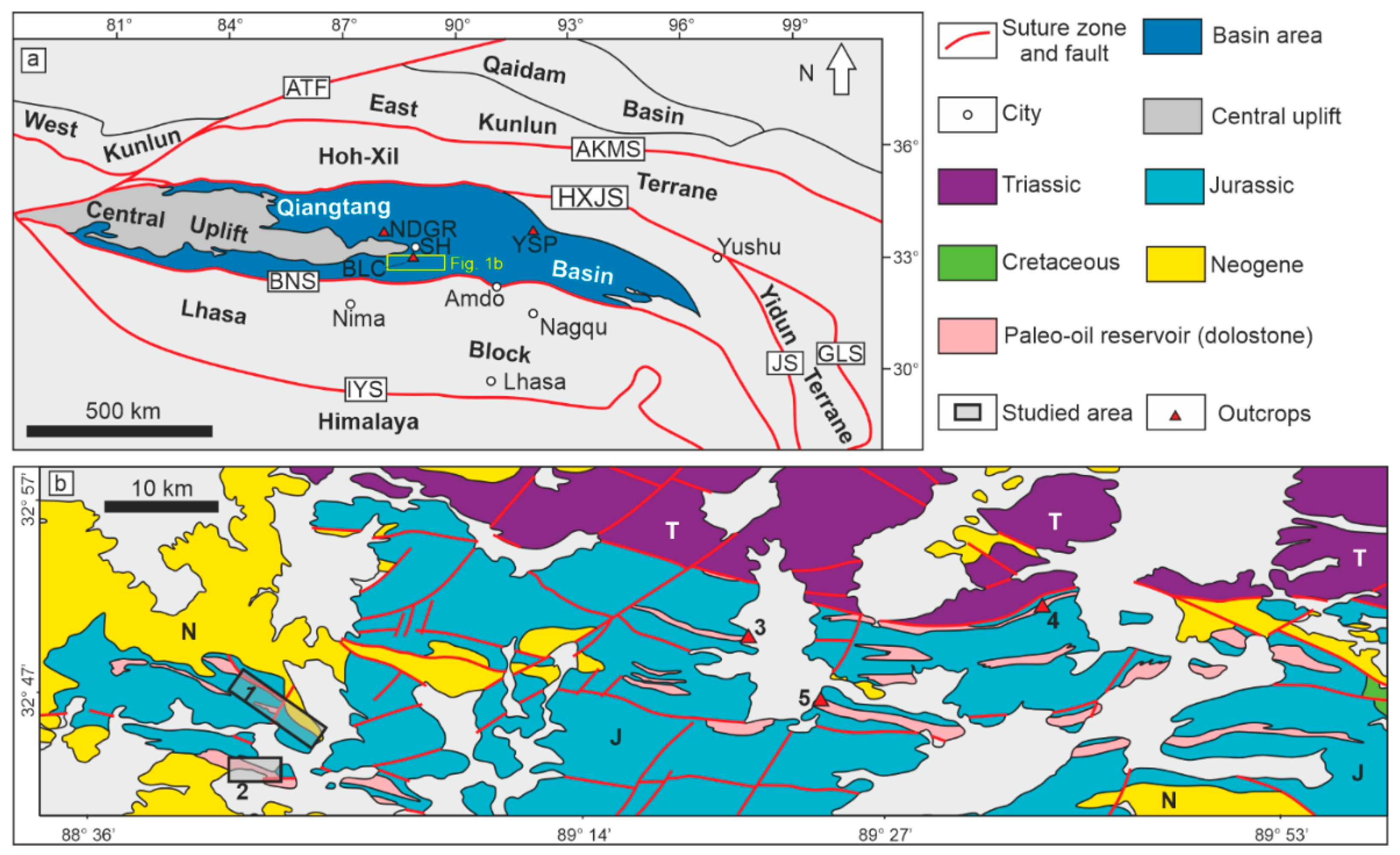
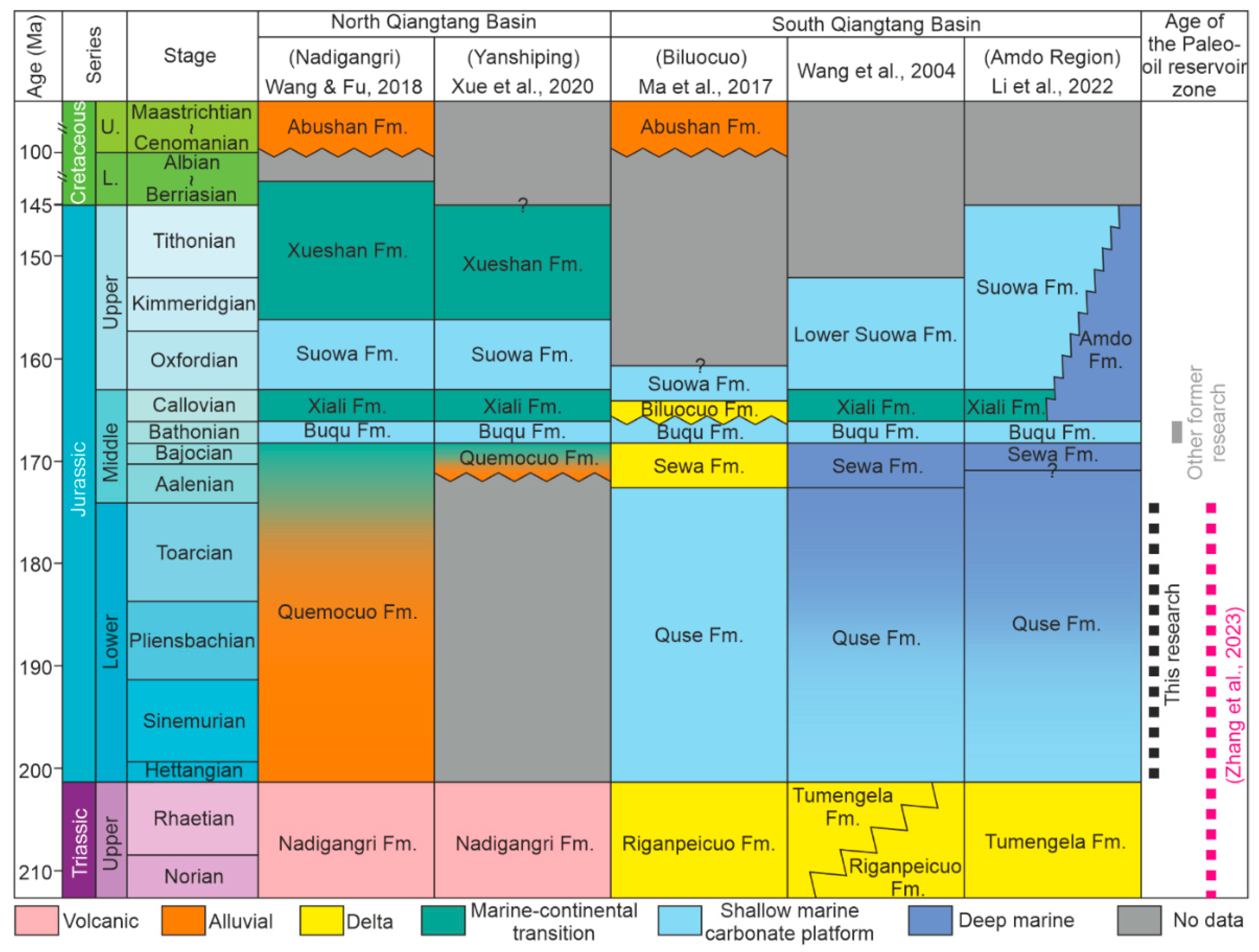
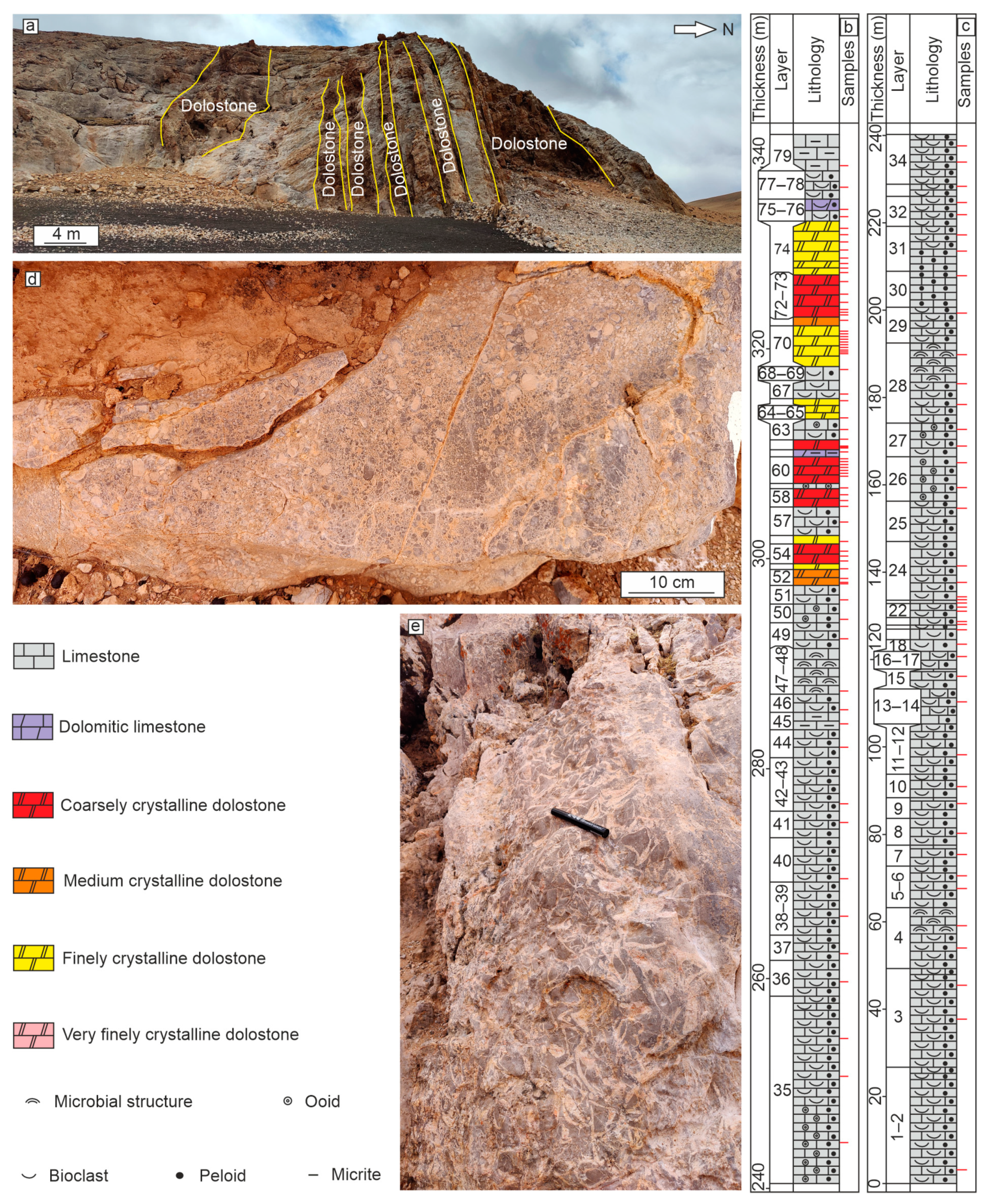
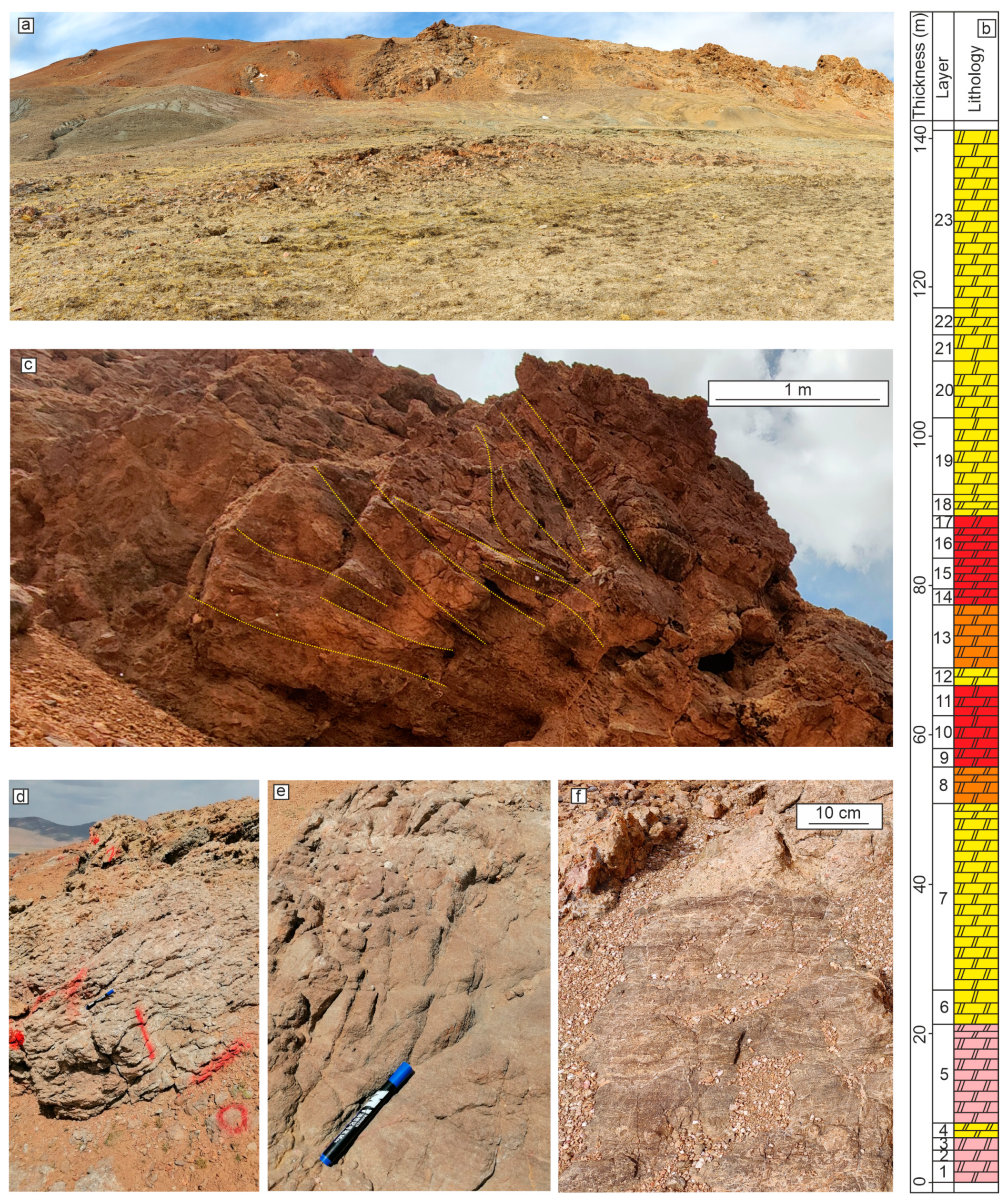

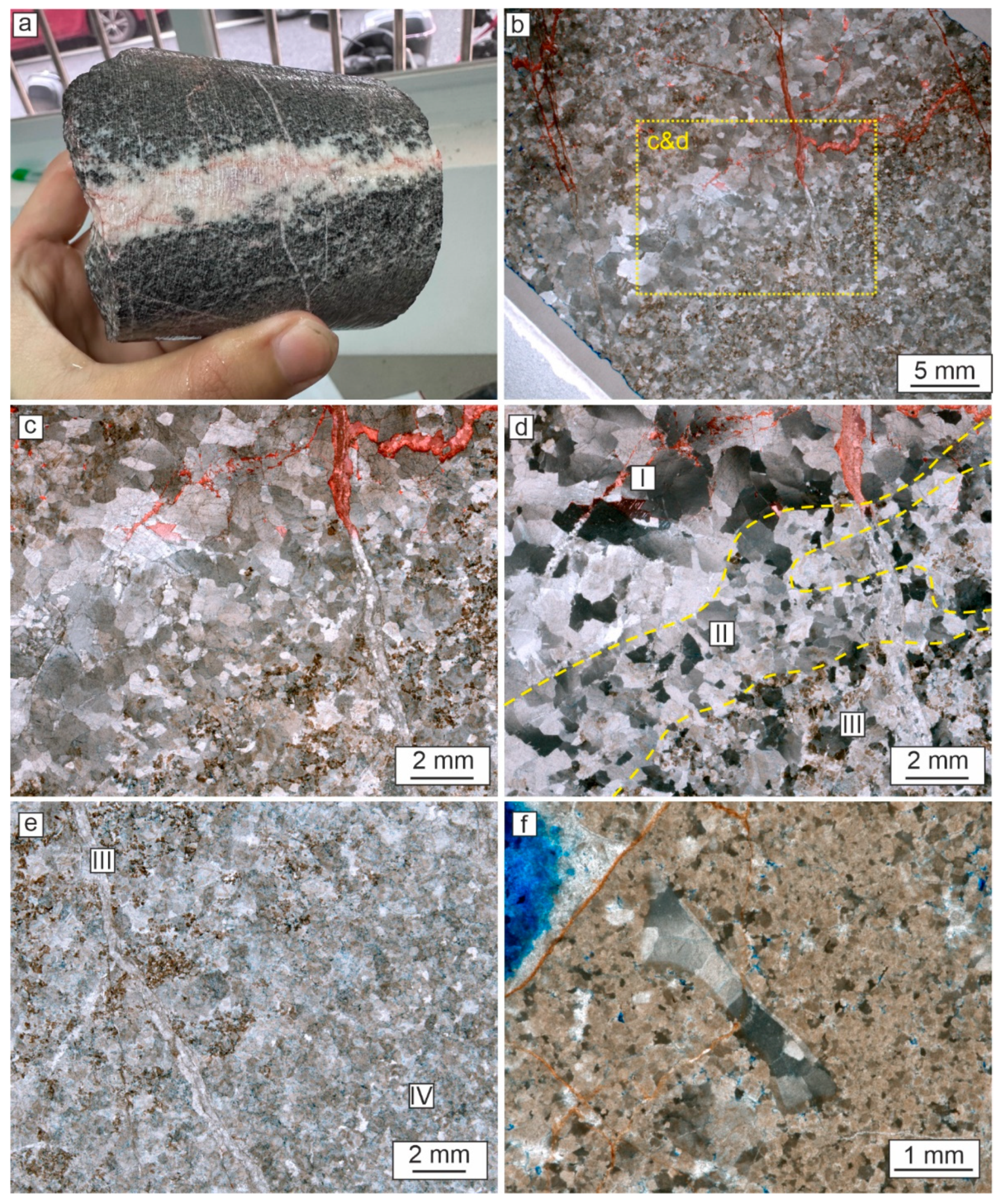

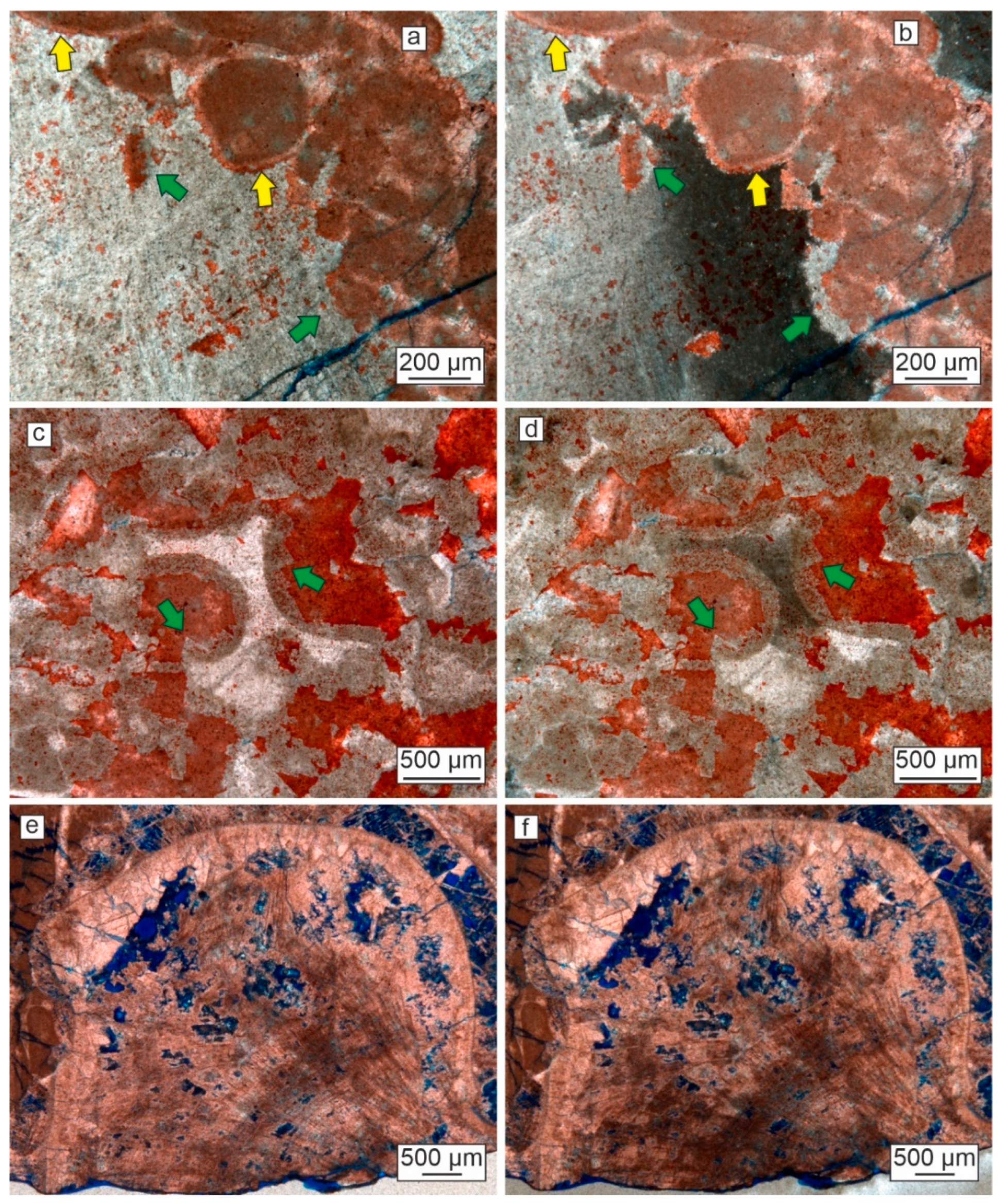

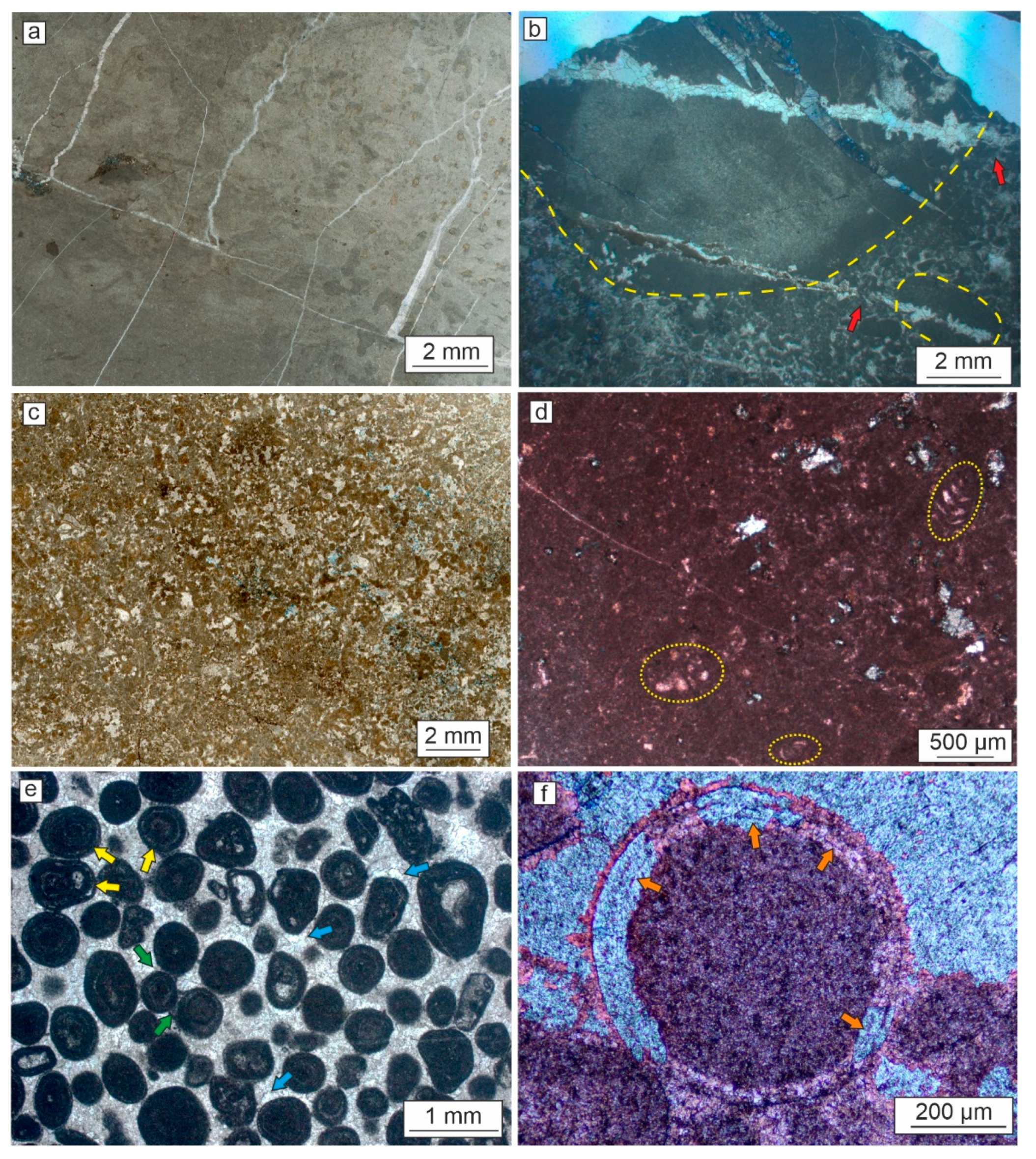
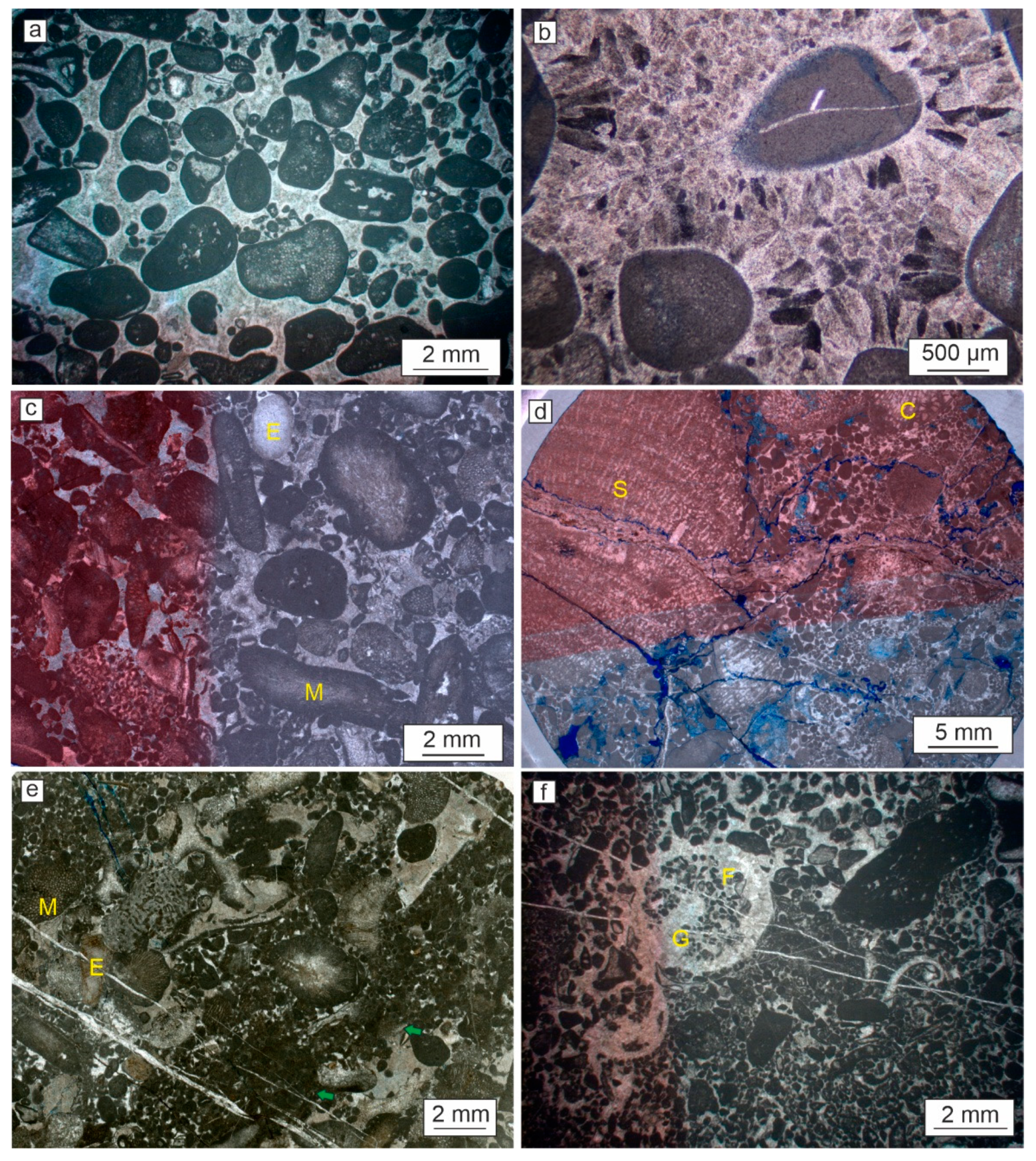
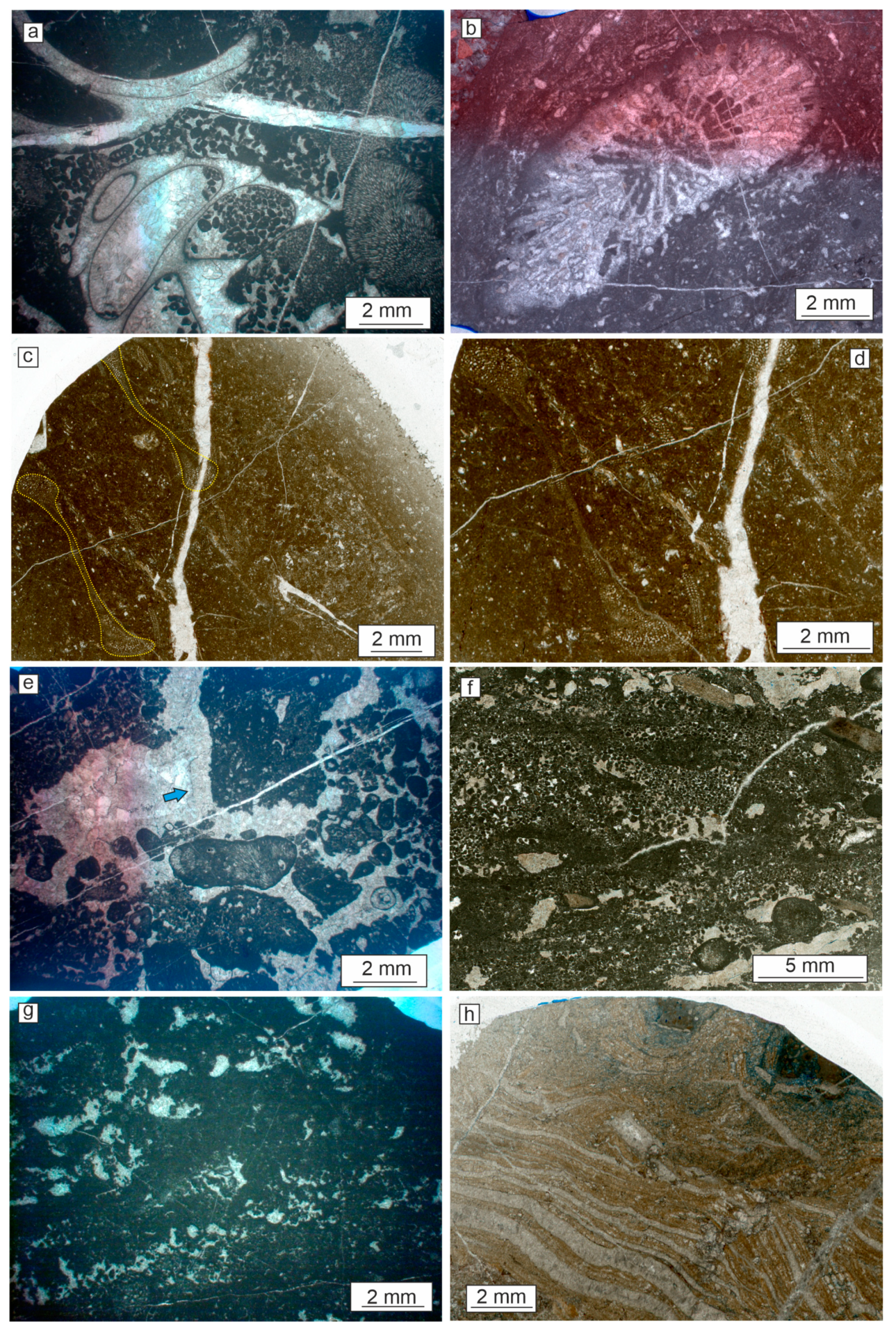
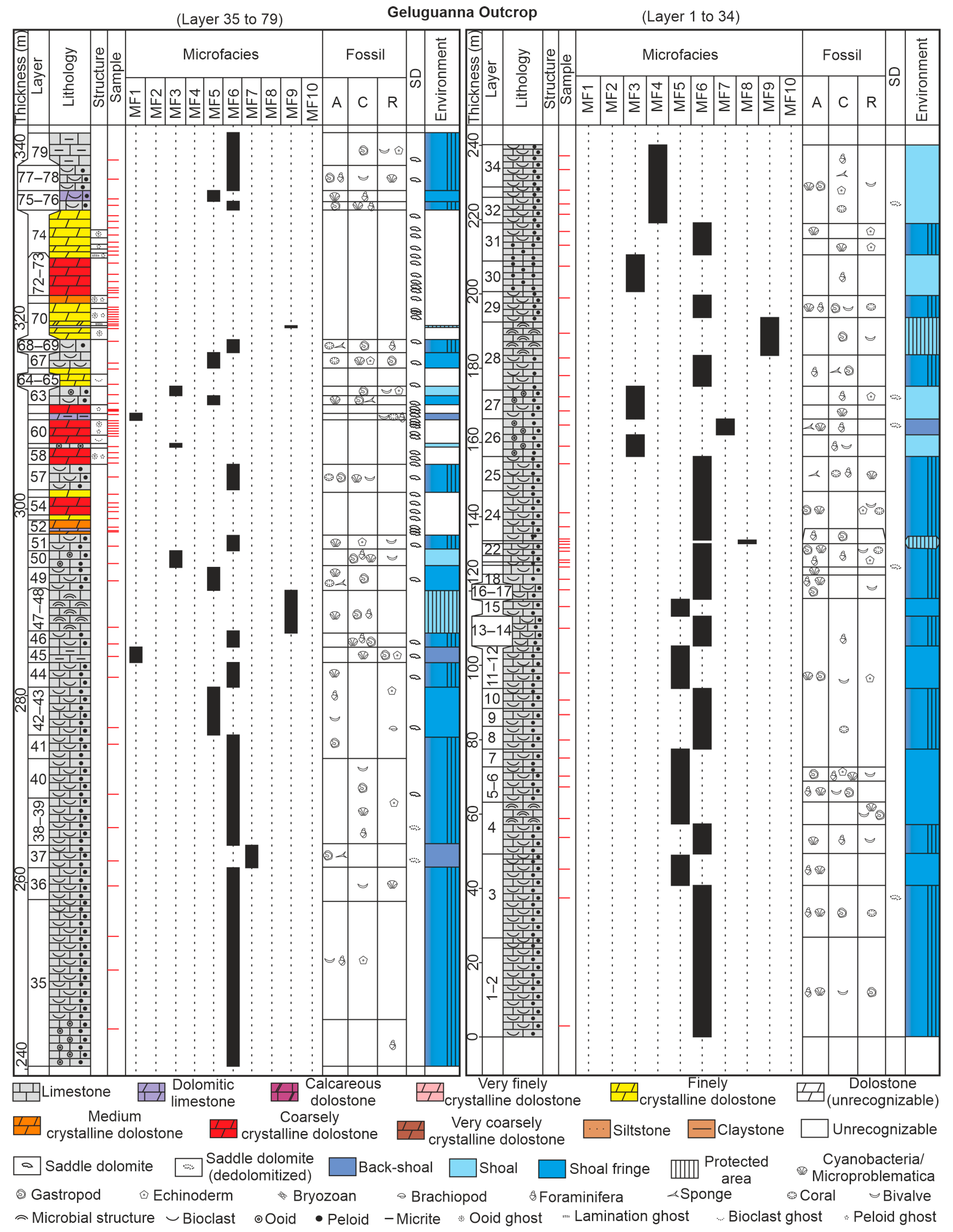
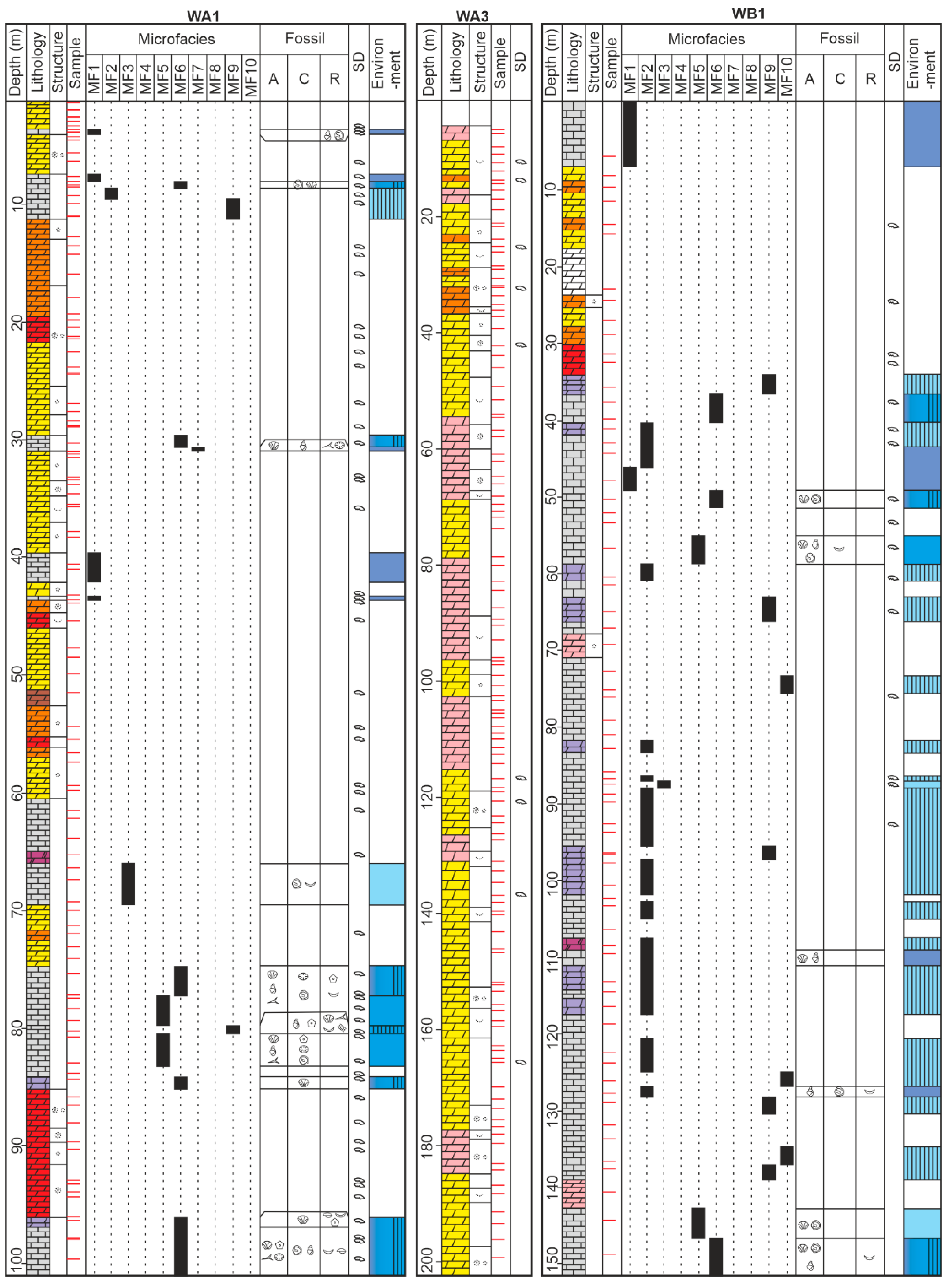
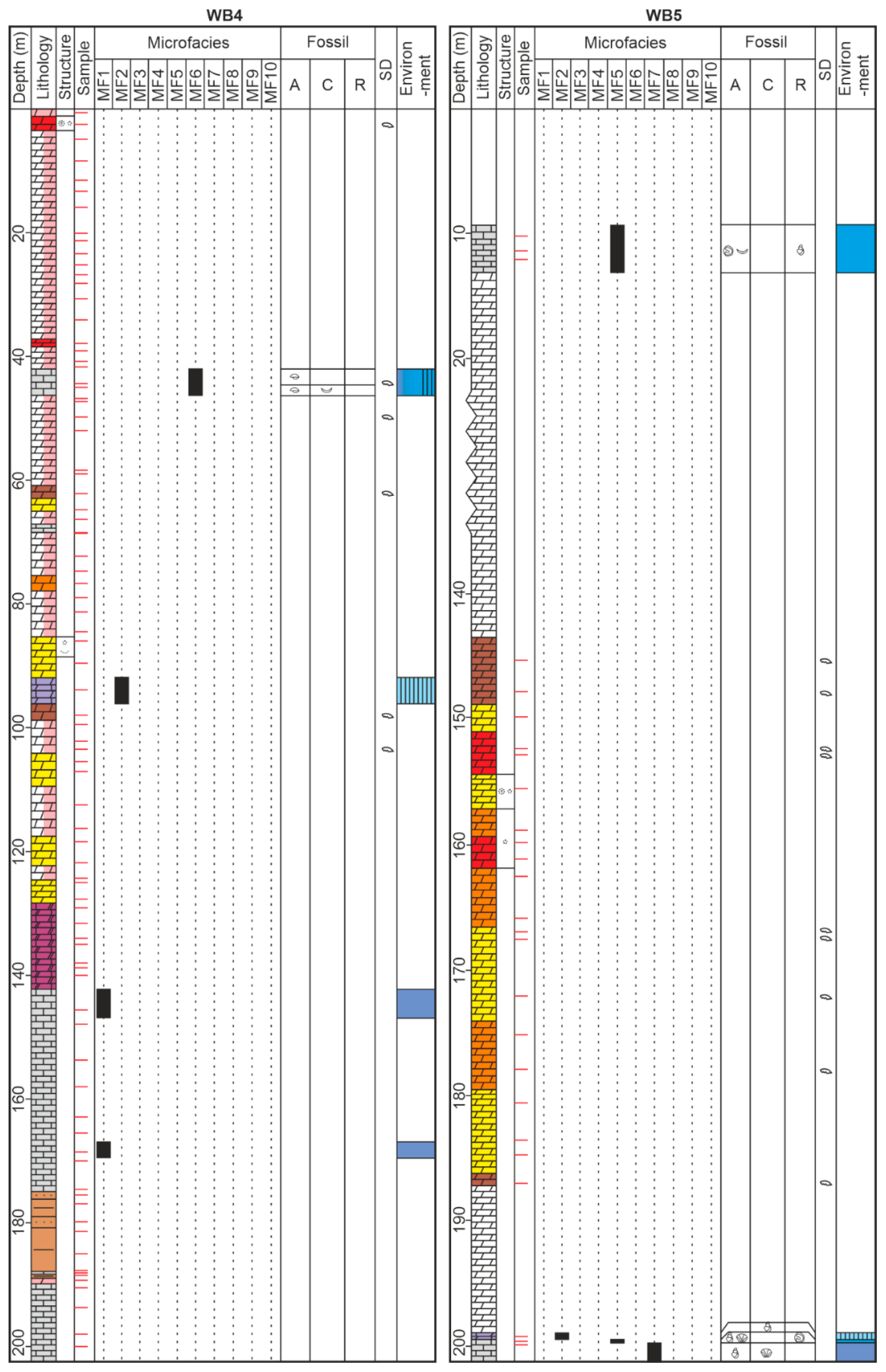
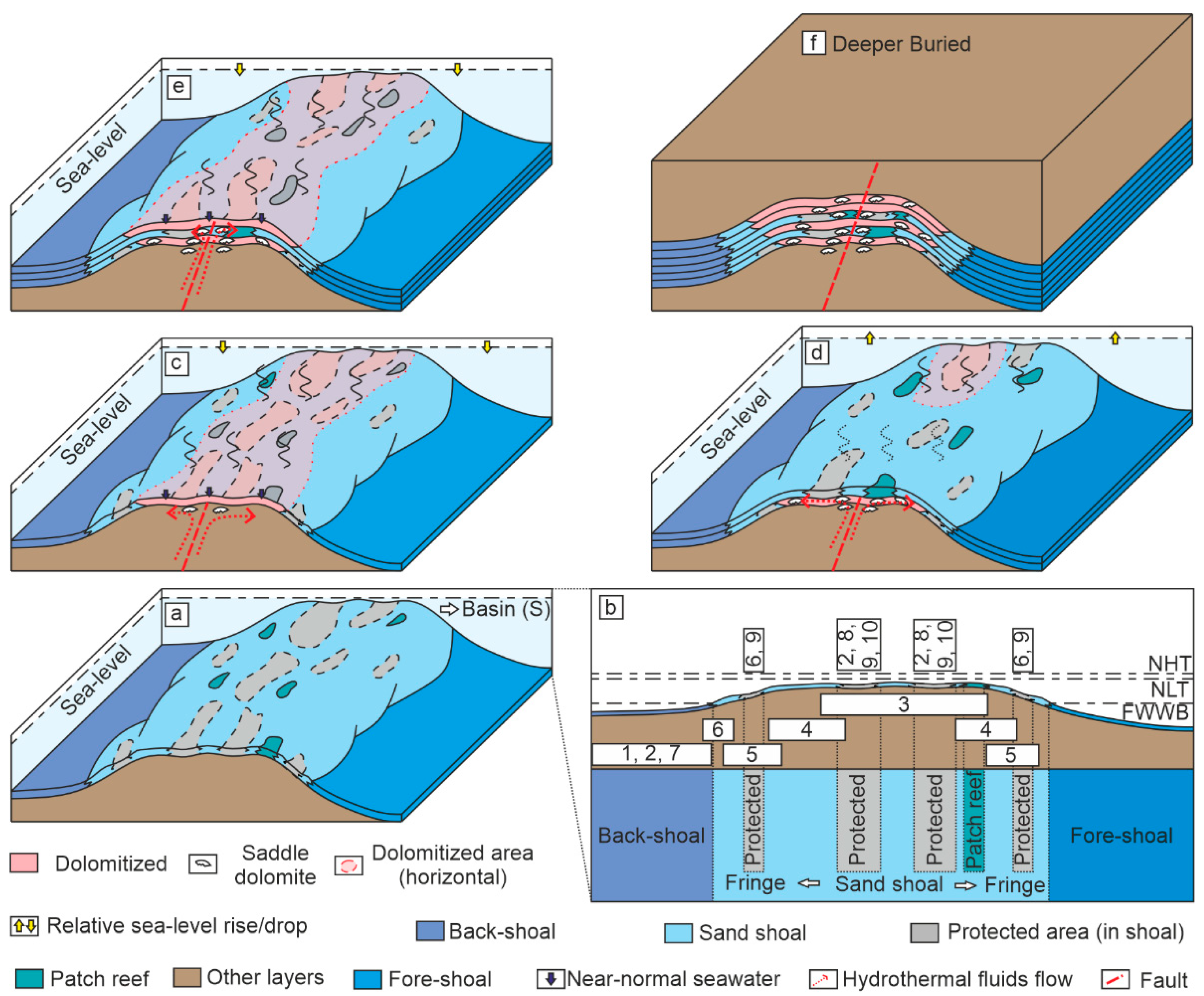
| Lithology | δ13C (VPDB, ‰) | δ18O (VPDB, ‰) | |
|---|---|---|---|
| Limestone | Range | −0.49~7.45 | −16.51~−7.73 |
| Mean | 2.05 | −11.55 | |
| Transition | Range | −1.91~4.10 | −13.75~−9.28 |
| Mean | 2.12 | −10.98 | |
| Dolostone | Range | −3.49~5.28 | −17.79~−7.62 |
| Mean | 2.10 | −10.12 |
| Lithology | Na (µg/g) | Sr (µg/g) | |
|---|---|---|---|
| Limestone | Range | 17.74~276.80 | 57.09~871.30 |
| Mean | 117 | 167 | |
| Transition | Range | 79.66~345.40 | 47.35~115.20 |
| Mean | 240 | 81 | |
| Dolostone | Range | 26.61~891.90 | 20.34~137.50 |
| Mean | 313 | 51 |
| Rock Types | Σ[REE+Y] | ΣLREE | ΣMREE | ΣHREE | Eu/Eu* | |
|---|---|---|---|---|---|---|
| Limestone | Range | 0.76~7.66 | 0.44~5.15 | 0.08~0.75 | 0.03~0.29 | 0.94~1.19 |
| Mean | 3.00 | 1.97 | 0.30 | 0.12 | 1.04 | |
| RD1 | Range | 1.20~1.32 | 0.50~0.57 | 0.10~0.11 | 0.08~0.09 | 0.75~0.83 |
| Mean | 1.26 | 0.54 | 0.11 | 0.08 | 0.79 | |
| RD2 | Range | 0.76~1.63 | 0.28~0.83 | 0.07~0.16 | 0.05~0.10 | 0.91~1.10 |
| Mean | 1.13 | 0.54 | 0.11 | 0.08 | 0.97 | |
| RD3 * | Range | - | - | - | - | - |
| Mean | 1.04 | 0.62 | 0.11 | 0.05 | 0.95 | |
| RD4 * | Range | - | - | - | - | - |
| Mean | 1.29 | 0.46 | 0.13 | 0.09 | 0.95 | |
| RD5 | Range | 0.42~0.74 | 0.24~0.38 | 0.04~0.08 | 0.02~0.05 | 1.03~1.25 |
| Mean | 0.58 | 0.31 | 0.06 | 0.03 | 1.14 |
| MFT | Key Characteristic | Interpretation |
|---|---|---|
| MF1 | Very high micrite content, rare grains and no lamination (due to bioturbation) | Very low water energy, not restricted, e.g., back-shoal [77] |
| MF2 | High micrite content, abundant grains (peloids/micritized ooids) | Low water energy, e.g., back-shoal or protected areas in shoal/shoal fringe |
| MF3 | Very well-sorted and well-rounded ooids, very low micrite content | Very high water energy, e.g., sand shoal [77,78] |
| MF4 | Well- to very well-sorted and well-rounded bioclasts (>2 mm), very low micrite content | High water energy, e.g., sand shoal [79] |
| MF5 | Poorly sorted bioclasts (>2 mm), very low micrite content | Moderate water energy, e.g., shoal fringe [79,80,81] |
| MF6 | Poorly sorted bioclasts (>2 mm), high micrite content | Moderate water energy (lower than that of MF5), e.g., shoal fringe to back-shoal, or protected areas in shoal fringe [79,80] |
| MF7 | Better preserved fossils, high micrite content | Low water energy, e.g., back-shoal [79] |
| MF8 | Subrounded lithoclasts with microbial structures, low micrite content between lithoclasts | In close proximity to autochthonous microbial structures |
| MF9 | Microbial layers | Protected/restricted areas in shoal/shoal fringe [82] |
| MF10 | Stromatolite | Protected/restricted areas in shoal [82] |
Disclaimer/Publisher’s Note: The statements, opinions and data contained in all publications are solely those of the individual author(s) and contributor(s) and not of MDPI and/or the editor(s). MDPI and/or the editor(s) disclaim responsibility for any injury to people or property resulting from any ideas, methods, instructions or products referred to in the content. |
© 2024 by the authors. Licensee MDPI, Basel, Switzerland. This article is an open access article distributed under the terms and conditions of the Creative Commons Attribution (CC BY) license (https://creativecommons.org/licenses/by/4.0/).
Share and Cite
Hao, R.; Pan, L.; Mu, N.; Li, X.; Fu, X.; Xiong, S.; Liu, S.; Zheng, J.; She, M.; Munnecke, A. Multi-Phase Dolomitization in the Jurassic Paleo-Oil Reservoir Zone, Qiangtang Basin (SW China): Implications for Reservoir Development. Minerals 2024, 14, 908. https://doi.org/10.3390/min14090908
Hao R, Pan L, Mu N, Li X, Fu X, Xiong S, Liu S, Zheng J, She M, Munnecke A. Multi-Phase Dolomitization in the Jurassic Paleo-Oil Reservoir Zone, Qiangtang Basin (SW China): Implications for Reservoir Development. Minerals. 2024; 14(9):908. https://doi.org/10.3390/min14090908
Chicago/Turabian StyleHao, Ruilin, Liyin Pan, Nana Mu, Xi Li, Xiaodong Fu, Shaoyun Xiong, Siqi Liu, Jianfeng Zheng, Min She, and Axel Munnecke. 2024. "Multi-Phase Dolomitization in the Jurassic Paleo-Oil Reservoir Zone, Qiangtang Basin (SW China): Implications for Reservoir Development" Minerals 14, no. 9: 908. https://doi.org/10.3390/min14090908
APA StyleHao, R., Pan, L., Mu, N., Li, X., Fu, X., Xiong, S., Liu, S., Zheng, J., She, M., & Munnecke, A. (2024). Multi-Phase Dolomitization in the Jurassic Paleo-Oil Reservoir Zone, Qiangtang Basin (SW China): Implications for Reservoir Development. Minerals, 14(9), 908. https://doi.org/10.3390/min14090908






